What is a Shunt Trip?


How To Connect a ShuntTrip?

You Might Also Like
8 comments:.
This comment has been removed by the author.
The information you have published here is really awesome, as it contains some great knowledge which is very essential for me. Thanks for posting it. Smoke Detector Alarm
It is a proficient article that you have shared here about electrical contractors in penzance I got some unique and valuable information from your article. Thankful to you for sharing this article here.
I generally check this kind of article and I found your article which is related to my interest. Genuinely it is good and instructive information. Thankful to you for sharing an article like this testing and tagging Melbourne
Cool stuff you have got and you keep update all of us. Electrical Contractor
Pretty good post. I just stumbled upon your blog and wanted to say that I have really enjoyed reading your blog posts. Any way I'll be subscribing to your feed and I hope you post again soon. Big thanks for the useful info. appliance installation and configuration
You have worked nicely with your insights that makes our work easy. The information you have provided is really factual and significant for us. Keep sharing these types of article, Thank you. Commercial Electrical Contractors Oregon
Follow Us On Facebook
Latest Post
Green electronics: sustainable pcb manufacturing practices.
.webp)
Popular Topics
Voltage drop calculation based on national electrical code.

How To Prepare Schedule of Loads

How to Calculate Voltage Drop of Distributed Loads

How to Calculate Transformer Voltage Drop

How to Perform Coordination Study of OCPD and Cable in Electrical Design

What is SELV and PELV Circuits?

What is the Importance of X/R Ratio?

What is Multiple Earthed Neutral?

Types and Classes of Current Transformers According to IEC 60441

Learning Is Not Necessarily An Outcome of Teaching

- Semiconductors
- $2 for 1-8 layer PCBs
What Is A Shunt Trip Breaker & How Does It Work? Detailed Guide
Hello readers welcome to the new post. In this post, we will learn What Is A Shunt Trip Breaker & How Does It Work. Detailed Guide. There is electrical system safety is the main parameter for the power system/ The main element that ensures the safety of electrical installation is the shunt trip breaker. In this post, we will discuss the all details shunt trip breaker and other parameters. So let’s get started What is a shunt trip
Table of Contents
What is a Shunt Trip Breaker?
If the circuit breaker trips it finds faults condition and automatically shuts off the current flow to prevent the circuit from overheating. The shunt trip breaker is an optional device for a circuit breaker that helps to trip the breaker remotely in any instant or automatically in case of surge saving any damage and instrument damage.
There are 2 main types fo shunt trip breakers first one is manual and the second one is automatic.
Manual witches help to off the breaker externally with the use of the remote button. Automatic switch off power when detecting surges from the external power supply.
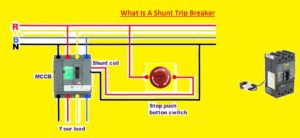
How Does a Shunt Trip Breaker Work?
Normally the current passes through the circuit breaker. But if these currents become high surges, the larger surge of power changes the electromagnet below the breaker switch, tripping the cutting power and switch.
The shunt trip breaker offers extra techniques to charge the electromagnet and trip switch, helping remote or automatic power shutoff. Some hunt trips are connected to an external power supply. When power surges get that source, signal flow from shunt trip to the breaker, mechanical cutting power.
The shunt trip can make a connection with the remote switch outside the building. Pushing the button on the switch sends a surge through shunt trip wiring and off the power.
Components of Shunt Trip Breaker
Read more Top Reasons Why Electric Outlet Stopped Working Breaker Not Tripped?
A shunt trip breaker comes with differnt components:
Main Contacts
This part of the shunt trip breaker is employed for carrying and interruption of current flow. Their main function s to control high current and make reliable connections
Shunt Coil
The shunt coil is an electromagnet that gets an electrical signal for breaker tripping. It produces a magentic field when gets energized releases the latch and starts the tripping process
Trip Mechanism
it helps to disconnect the mechanical circuit when the breaker trips. it has a latch that helps contact during normal working but releases due to trip signal.
Control Wiring
The control wiring triggers the device remotely or control panels. It works for remote activation of the shunt trip to provide the protection layers
Why Are Shunt Trip Breakers Important?
irrespective optional nature of the shunt trip breaker, it can be an important safety instrument in a power system. In a result, many engineers use this breaker as a layer of security since they save damage during power surges.
This breaker is good for many fonts but it’s commonly used during fire. By turning off power if a fire break out, the electrical hazard is no main risk. Some connections shunt trip to smoke alarm in homes, for power automatically off when detector trigger alarm. It not be good option, since in some conditions smoke alarm gets off due to steam from the shower of smoke from the kitchen
Applications of Shunt Trip Breakers
- Commercial buildings
- Hospitals and healthcare facilities
- Data centers
- Industrial facilities
- Laboratories
- Hotels and resorts
Advantages of Shunt Trip Breakers
- The main benefit of a shunt breaker is that it can remotely shut off in case of any fault. It quickly works and disconnects power in fire which helps to avoid damage in the home and protects people.
- These devices also increase safety levels and security by automating off power to the circuit if there is any fault. it helps to save electrical fires and any other damage.
- The shunt breaker is easily connected and confined with a power system, so it is easy to install the device in the building.
- The shunt breaker is a less cost solution for safety measures in buildings and industries. it is less costly to buy and connect and helps to save homes and buildings in the result of high fault.
- Shunt breakers support many electrical systems and devices so it is versatile devices that are used for the protection of circuits.
Troubleshooting of Shunt Trip Breakers
- Regular inspection of the breaker helps to find the symbols of damage or wear.
- Perform differnt electrical tests to check the it is working accurately or not
- Make sure there are no dust particles on the breaker so clean it regularly
- Make it properly lubricated
- After finding the faults solve it
Comparison with Other Circuit Protection Devices
Shunt trip breakers vs. standard circuit breakers, shunt trip breakers vs. ground fault circuit interrupters (gfcis), shunt trip breakers vs. arc fault circuit interrupters (afcis), how to choose right shunt trip breaker.
- Choose according to the voltage rating of your circuit
- it has compatibility with electrical panels and other protection devices used in circuitry
Shunt trip breaker wiring
Its wiring is very simple and easy. The shunt coil has two terminals one used for voltage supply and the other for neutral. The supply is about 120 volts AC and the neutral is connected to the neutral point of the breaker
The shunt coil is attached in a series combination with the push button. When we press the button it closes teh circuit to the shunt coil that trips the breaker. It is good to check that the shunt coil is rated for a similar voltage to the breaker. If the shunt coil does not have the same rating it can be damaged
Diagram of Shunt Trip Breaker Wiring Diagram
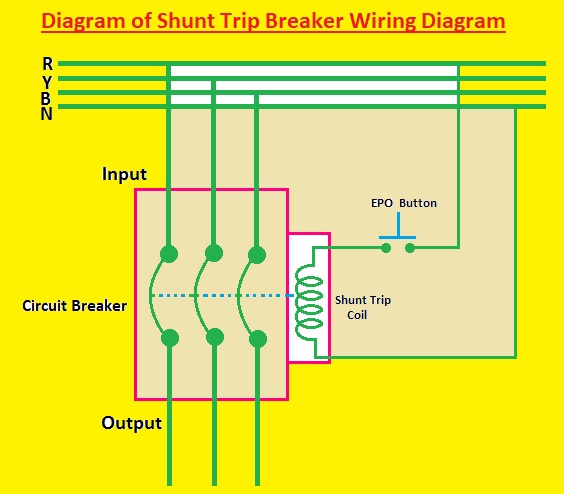
WHICH TYPE OF SHUNT TRIP BREAKER TO USE?
The manual breaker is best to use for small buildings or conditions where any technical staff is available to reset the breaker,. The automatic breaker can be best for larger-size buildings or conditions where there is no option for staff for breaker resetting.
it is also preferred for trigger shunt trip breakers at a distance or remotely. These relays are connected to fire alarm systems and can send a signal to the breaker for tripping if there is any fault.
Read more How Many Outlets on a 15 Amp Circuit Breaker?
How Many Outlets on a 15 Amp Circuit Breaker?
60 Amp Wire Size – Which AWG is Best for 60 Amp Breaker
Difference Between a Single and Double Pole Breaker
Where is the Doorbell Breaker Located? Easy Way to Findout
Difference Between Fuse and Circuit Breaker
How does a shunt trip breaker work?
A shunt trip breaker controlled by a small current from some distance. It is best for uses where it has the ability to off power to circuitry from distant points, like fire alarm systems
How is a shunt trip breaker wiring?
The shunt trip terminals are connected to the top and lower parts of the circuitry breaker. The small-size wire is used for wiring the shunt trip breaker between the shunt trip points and the remote source of supply. The power source can be battery relays
What is the purpose of a shunt with a relay?
The shut relay provided the remote tripping for the breaker. The shunt low resistance conductor is connected between the circuit breaker and relay. When current passes through the shunt, it makes a magnetic field that functions as the relay. The relay close contacts that trip the breaker.
What is shunt trip and under voltage?
Shunt trip and under voltage are differnt terms used for the differnt tripping methods of the breaker. Shunt trip use a shunt to have remote tripping. Under voltage is tripping off the circuit breaker when voltage loses less than a certain value
Where is shunt trip used?
- Fire alarm systems
- Security system
- Power distribution
- Industrial control systems
What is the difference between shunt and resistance?
The main difference between a resistor and a shunt is the temperature coefficient of thermal EMF . For resistors thermal EMF is not considered but for shunt resistors considered, based on temperature values two different conductive materials generate variable voltage
What is the purpose of a shunt breaker?
The shunt trip breaker is an optional device for a circuit breaker that helps to trip the breaker remotely or automatically when a surge exists, any damage, or emergencies.
Is the shunt resistor AC or DC?
Shunt resistors can be used for both AC and DC circuits. Though the value of the shunt resistor will be different from ac and DC circuits
Where are shunt trip breakers required?
If you are thinking that if shunt trip breaker is needed find that it is required in an electrical system where is a need for fast and easily shut-off power in case of a fault like fire.
Why is it called a shunt resistor?
The term shunt originated from the Latin word “scindere”, which means to split. A shunt resistor is used for spiting current in circuitry.
Why is low resistance called shunt?
When the resistor is connected with another resistor of low values then the equivalent resistance is lower than a single resistor that shunts the resistor.
What is another name for a shunt resistor?
it also called a shunt resistor is a current-dividing resistor.
What is unit of shunt resistance?
The unit of shunt resistance is ohm (Ω).
What is shunt resistance formula?
The shunt resistance formula is:
- Rs is the shunt resistance
- V is the voltage of the shunt resistor
- I is the current passing through the shunt resistor
What is shunt release in a circuit breaker?
The cut-off switch opens the solenoid coil electrical circuit if the breaker contact is opened. The solenoid coil so carries momentary current and is not rated for continuous duty. This process needs an external control supply or auxiliary supply for operation.
What is the difference between a shunt trip and series trip?
What are the different types of shunt trip breakers, does a shunt trip breaker need a neutral, what is the difference between shunt trip and shunt close, share this:.
Wholesale PCBs SMT Stencil & PCBA Service Provider
Special offer:$2 for 1-8 layer PCBs
Sign Up & Get 54$ Coupon
Author: Scott Spencer
I am professional content writer have professional degree in engineering. I have worked in different famous companies and also providing technical and seo based services clients all over the world. With that i am sharing my knowledge to engineering and technical students and new learners to enhance their learning and get new ideas in technical fields. Follow him on Twitter and Facebook .
Related Posts
Why Should Industries Choose Oil-Free Air Compressors? May 14, 2024
The 6 Critical Issues in the Construction Industry and Suggested Solutions in 2024 May 13, 2024

Writing Of Engineering Thesis and Dissertation: How to Ace it April 30, 2024
An Overview of the Assembly Line: The Technology that Transformed the Manufacturing Industry April 30, 2024

Leave a Reply Cancel reply
Your email address will not be published. Required fields are marked *
Save my name, email, and website in this browser for the next time I comment.
Post comment

Galvin Power is reader-supported. When you buy via our links, we may earn a commission at no cost to you. Learn more
What is a Shunt Trip Breaker and How Does It Work?
Written by Edwin Jones / Fact checked by Andrew Wright
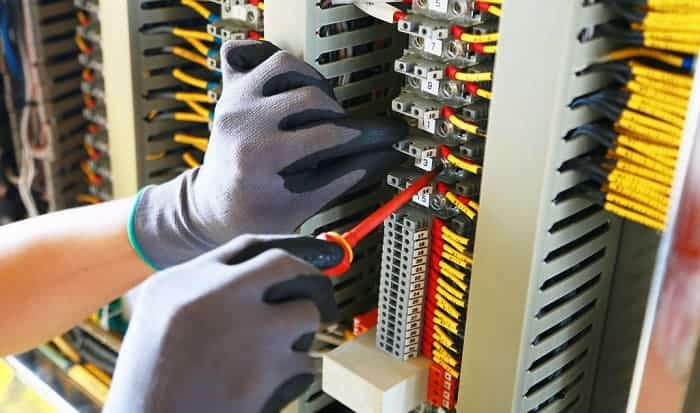
What is a shunt trip breaker? Does it add protection to your electrical system?
The shunt trip breaker is a combination of the shunt trip accessory and the main circuit breaker. This installs on the main breaker to add protection to your electrical system. This adds security to your electrical system as it manually or automatically cuts the electric supply in your circuit.
This accessory can help prevent short circuits and avoid electrical damage should a disaster occur in your home.
Let me tell you more about the shunt trip breaker to help you decide if you need additional protection for your electrical system.
Table of Contents
What is Shunt Trip Breaker and How Does It Work
Where are shunt trip breakers most used, how to install a shunt trip accessory to the breaker.

You should know that shunt trip breakers are different from GFCI circuit breakers.
The GFCI circuit breaker contains one big white tail wire for neutral connections only. It cannot be connected to any control package because the GFCI circuit breaker is solely designed to detect a sudden electrical surge. It has no other purpose but to cut power in case of a short.
Meanwhile, the shunt trip breaker wiring comprises two wires. One connected to the ground, and another to a control system. The control system can be connected to a sensor or to a manual switch. When activated, the shunt trip accessory will cause the main breaker to trip.
For example, if you install a shunt trip with a smoke detector, it will activate and cut off the power should the smoke sensor trigger. It can also be installed with a remote switch , allowing you to trip your breaker manually.
It is crucial to know the difference between a regular circuit breaker and a circuit breaker installed with shunt trip accessories.

The shunt trip definition means that it is a way to cut off electrical power through other sensors, not just via thermal activation. Since this is an optional accessory for a circuit breaker, it is not required for a home electrical system.
However, it is recommended for added safety. This is especially true if you’re working with industrial machinery. Furthermore, you can use it as a manual emergency switch to shut down your main breaker.
Before installing a shunt trip, consider its cost and your existing system. You may need to change the breaker panel and circuit breakers, especially if it is not compatible with shunt trips. You may also need a new line to connect the remote emergency switch to your breaker box.
Generally, most commercial kitchens, elevators, and offices have this shunt trip breaker because it is required. Commercial kitchens use this device in compliance with ANSI/ASME CSD-1, while elevators and escalators comply with ASME A17.1. These codes refer to the controls and safety standards provided by ASME’s.
This question is a topic of discussion among Reddit members as well. Join the conversation here:
Found at a dominos by u/Guilty_Sympathy_496 in electricians
Mostly, installing a shunt trip relay requires that the breaker and the shunt be from the same maker. Also, not all breaker models are compatible with this accessory.
Once you’re sure that your system can take a shunt trip accessory, installation is pretty much straightforward. You can watch this video by Aaron CBIONE for some tutorials.
Note: Every circuit breaker comes with different instructions. It would depend on the brand and model of the breaker .
However, the critical part of every installation is that you need to connect the shunt to your sensor. You may need a shunt trip breaker diagram as a reference to ensure correct installation.
Also, check the brand and model of your breaker before proceeding with the installation. Some makers only allow a factory install of the shunt trip and other accessories. DIY installation may void the warranty of your breakers. It’s best to read up on the manual or consult an electrical professional before making any changes.
What is a shunt trip breaker? The shunt trip is an optional accessory for a circuit breaker for added protection to your system. It is designed to connect to a secondary sensor. It will trip the breaker automatically if the sensor is triggered. It can also be activated via a remote switch that you can install.
Do you think that a circuit breaker is enough to protect your investment? Or do you want an additional layer of protection for your electrical circuit? If you’re not decided yet, reach out to me in the comments section below, and I will be happy to help you.

I am Andrew Wright. With 8 years of experience designing, installing, and maintaining electrical power systems. I love my job, and I have always wanted to offer others the necessary help so they can take care of their houses.
The Enlightened Mindset
Exploring the World of Knowledge and Understanding
Welcome to the world's first fully AI generated website!
Understanding Shunt Trip: What it is, How to Use it & Troubleshooting Tips
By Happy Sharer
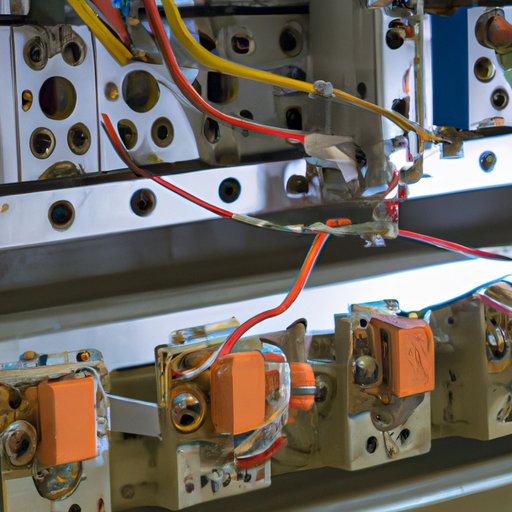
Introduction
A shunt trip is an electrical circuit designed to shut down equipment or activate alarms in the event of an emergency. It’s an important safety feature that helps protect people and property from potential harm. In this article, we’ll explore what a shunt trip is, how it works, and the advantages of installing one.

Exploring the Basics of a Shunt Trip
A shunt trip is a type of circuit breaker, which is an electrical device designed to shut off the power supply when a fault is detected. The circuit breaker is connected to a sensing device, like a pressure switch or smoke detector, which detects any changes in the environment. If a hazard is detected, the circuit breaker will be triggered, shutting off the power supply.
The shunt trip circuit is made up of three components: a sensing device, a control relay, and a circuit breaker. The sensing device is installed near the equipment being monitored and detects any changes in the environment. When the sensing device detects a hazardous condition, it sends a signal to the control relay, which then activates the circuit breaker, stopping the flow of electricity.
The shunt trip circuit is an important safety feature that can help prevent serious accidents and injuries. According to a study by the National Institute for Occupational Safety and Health (NIOSH), “the use of shunt trip circuit breakers can help reduce the risk of electrical shock and other hazards in the workplace.”

The Advantages of Installing a Shunt Trip
Installing a shunt trip circuit can provide numerous benefits, including improved safety, increased efficiency, and cost savings. Here are some of the most common uses for a shunt trip circuit:
- Safety: A shunt trip circuit can be used to shut down equipment in the event of an emergency, helping to prevent serious accidents and injuries.
- Efficiency: By automatically shutting down equipment when a hazardous condition is detected, a shunt trip circuit can help reduce downtime and improve efficiency.
- Cost Savings: Installing a shunt trip circuit can help save money by reducing the need for manual inspections and maintenance.
There are several different types of shunt trips available, depending on the application. Common types include magnetic shunt trips, thermal overloads, and ground fault circuit interrupters (GFCIs). Understanding the differences between these types of shunt trips can help you choose the right one for your needs.
Troubleshooting a Shunt Trip Circuit
When troubleshooting a shunt trip circuit, it’s important to identify any potential faults or issues. Common problems with shunt trip circuits include faulty wiring, incorrect settings, and damaged components. Here are some tips for troubleshooting a shunt trip circuit:
- Check the Wiring: Check all the wiring connections to make sure they are secure and in good condition.
- Check the Settings: Make sure the shunt trip circuit is set correctly according to the manufacturer’s instructions.
- Check the Components: Make sure all components are in good working order and replace any damaged parts.
A shunt trip is an important safety feature that can help protect people and property from potential harm. It’s a type of circuit breaker that can be used to shut down equipment or activate alarms in the event of an emergency. Installing a shunt trip circuit can provide numerous benefits, including improved safety, increased efficiency, and cost savings. When troubleshooting a shunt trip circuit, it’s important to check the wiring, settings, and components to identify any potential faults or issues.
In summary, a shunt trip is a valuable safety feature that can help reduce the risk of accidents and injuries. Understanding how it works and how to troubleshoot it can help ensure it functions properly and provides maximum protection.
(Note: Is this article not meeting your expectations? Do you have knowledge or insights to share? Unlock new opportunities and expand your reach by joining our authors team. Click Registration to join us and share your expertise with our readers.)
Hi, I'm Happy Sharer and I love sharing interesting and useful knowledge with others. I have a passion for learning and enjoy explaining complex concepts in a simple way.
Related Post
Exploring japan: a comprehensive guide for your memorable journey, your ultimate guide to packing for a perfect trip to hawaii, the ultimate packing checklist: essentials for a week-long work trip, leave a reply cancel reply.
Your email address will not be published. Required fields are marked *
Expert Guide: Removing Gel Nail Polish at Home Safely
Trading crypto in bull and bear markets: a comprehensive examination of the differences, making croatia travel arrangements, make their day extra special: celebrate with a customized cake.

Tech Related Blog
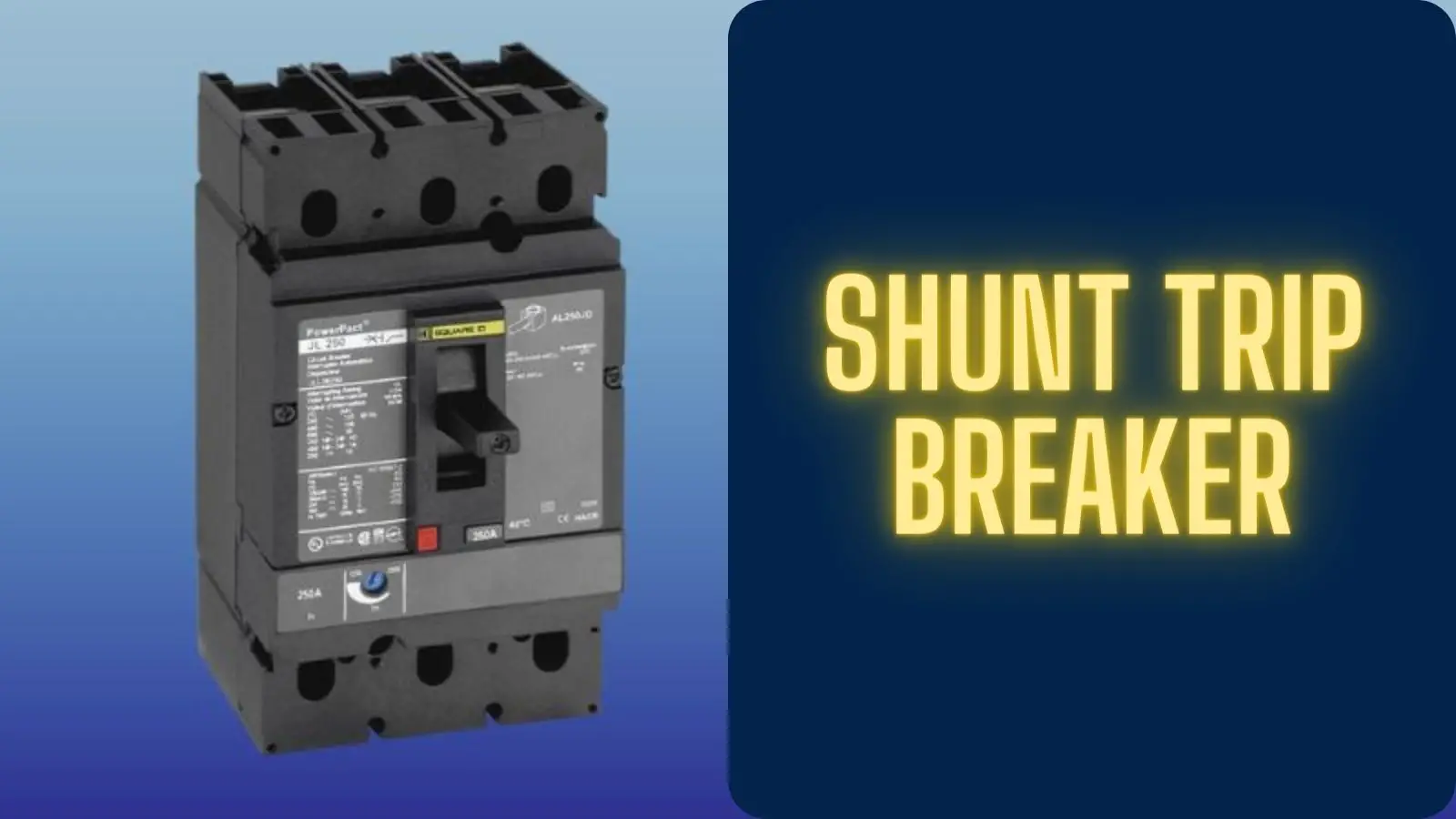
Understanding Shunt Trip Breaker: Function, Applications, and Benefits
Introduction.
In the realm of electrical distribution systems, safety and control are paramount. Shunt trip breakers, a specialized type of circuit breaker, play a crucial role in enhancing safety and efficiency in various applications. This article delves into the mechanics, applications, and benefits of shunt trip breakers, shedding light on their significance in modern electrical systems.
What is a Shunt Trip Breaker?
A shunt trip breaker is a type of circuit breaker that features an additional accessory known as a shunt trip coil. Unlike a standard circuit breaker, a shunt trip breaker can be remotely tripped open using an external control signal. This control signal energizes the shunt trip coil, causing the circuit breaker to trip and open the electrical circuit.
Functionality of Shunt Trip Breaker
A shunt trip breaker is a type of circuit breaker commonly used in electrical distribution systems. It includes an additional feature called a shunt trip, which allows for remote tripping of the breaker under specific conditions. Here’s how it works:
- Basic Circuit Protection : Like a standard circuit breaker, a shunt trip breaker is designed to protect electrical circuits from overload or short circuit conditions. It interrupts the flow of electricity when it detects an excessive current, preventing damage to the electrical system and reducing the risk of fire or electrical hazards.
- Shunt Trip Mechanism : The shunt trip mechanism is an additional component installed within the circuit breaker. It consists of a solenoid coil that, when energized, creates a magnetic field. This magnetic field pulls down a latch or mechanism within the circuit breaker, causing it to trip and open the circuit.
- Remote Tripping : The key functionality of a shunt trip breaker is its ability to be remotely tripped. This is achieved by providing an external control signal to energize the solenoid coil of the shunt trip mechanism. The control signal can be generated by various means such as a manual switch, a relay, a control panel, or an automated system like a building management system (BMS) or a fire alarm system.
- Emergency Shutdown : In case of emergencies, such as fire or other hazardous situations, the breaker can be remotely tripped to de-energize certain circuits or equipment.
- Security : In sensitive areas or facilities, shunt trip breakers can be integrated into security systems to remotely disable power in certain areas.
- Maintenance : They can be used to facilitate maintenance procedures by providing a means to de-energize specific circuits or equipment remotely.
- Integration with Other Systems : Shunt trip breakers can be integrated with other systems such as fire alarm systems, security systems, or industrial automation systems to provide coordinated responses to various events.
- Resetting : After the shunt trip feature is activated and the breaker trips, it typically needs to be manually reset. This ensures that power is not automatically restored after the fault condition is cleared, allowing for inspection and maintenance before restoring power.
In summary, a shunt trip breaker combines the functions of a standard circuit breaker with the added capability of remote tripping, making it suitable for a wide range of applications where remote control and safety are paramount.
Applications of Shunt Trip Breakers
Shunt trip breakers find various applications across different industries and environments where remote tripping capability is essential for safety, security, or operational reasons. Here are some common applications:
- Commercial Buildings : In commercial buildings, shunt trip breakers can be used to integrate with fire alarm systems. In the event of a fire alarm activation, the breaker can be remotely tripped to de-energize specific circuits or equipment, such as HVAC systems, elevators, or lighting, to facilitate safe evacuation or firefighting operations.
- Industrial Facilities : Shunt trip breakers are widely used in industrial facilities for emergency shutdown procedures. They can be integrated with safety systems to automatically trip certain circuits or equipment in the event of hazardous conditions, such as the detection of gas leaks, chemical spills, or other emergencies.
- Data Centers : In data centers, where uninterrupted power supply is critical, shunt trip breakers can be employed as part of the facility’s emergency power-off (EPO) system. In case of a severe malfunction or security breach, the EPO system can remotely trip the breakers to shut down power to all equipment and prevent potential damage to sensitive IT infrastructure.
- Healthcare Facilities : Shunt trip breakers are used in healthcare facilities to support life safety systems. They can be integrated with emergency response systems to deactivate non-critical equipment and ensure power availability for essential medical devices, lighting, and communication systems during emergencies or power outages.
- Laboratories : Laboratories often utilize shunt trip breakers to ensure the safety of personnel and prevent accidents. Breakers can be integrated with gas detection systems, chemical spill sensors, or other safety devices to automatically disconnect power to hazardous equipment or areas in the event of a malfunction or emergency.
- Military Installations : In military installations, shunt trip breakers are employed to enhance security measures. They can be integrated into perimeter security systems or command and control centers to remotely cut power to specific areas or equipment in response to security threats or breaches.
- Critical Infrastructure : Shunt trip breakers are deployed in critical infrastructure facilities such as power plants, water treatment plants, and transportation hubs to support emergency response protocols. They provide a means to quickly isolate and de-energize critical systems or equipment during emergencies, natural disasters, or security incidents.
Overall, shunt trip breakers play a vital role in enhancing safety, security, and operational efficiency across various industries and applications where remote tripping capability is essential.
Benefits of Shunt Trip Breakers
Shunt trip breakers offer several benefits across various applications due to their remote tripping capability and integration with safety and security systems. Some of the key benefits include:
- Enhanced Safety : Shunt trip breakers improve safety by providing a means to remotely de-energize specific circuits or equipment in emergencies. This helps prevent accidents, mitigate risks, and protect personnel, property, and the environment from potential hazards.
- Quick Response : The remote tripping feature allows for rapid response to emergencies, such as fire alarms, gas leaks, or security breaches. Breakers can be tripped instantly to cut power to critical systems or equipment, facilitating prompt evacuation, containment, or mitigation measures.
- Customizable Control : Shunt trip breakers offer flexibility in control and operation. They can be integrated with various control systems, including fire alarm systems, security systems, or building management systems, allowing for customized programming and coordination of response actions based on specific requirements and scenarios.
- Reduced Downtime : In industrial and commercial environments, shunt trip breakers help minimize downtime by enabling targeted shutdowns of equipment or processes during maintenance, repairs, or troubleshooting. This improves operational efficiency and reduces the impact of disruptions on productivity and revenue generation.
- Enhanced Security : Shunt trip breakers enhance security measures by providing a means to remotely disable power to specific areas or equipment in response to security threats or breaches. They can be integrated with access control systems, surveillance systems, or perimeter security systems to bolster overall site security and resilience.
- Compliance with Regulations : Shunt trip breakers help organizations comply with safety and regulatory requirements. By incorporating remote tripping capability into their electrical systems, facilities can meet standards and guidelines related to fire safety, emergency preparedness, environmental protection, and occupational health and safety.
- Protection of Critical Infrastructure : Shunt trip breakers play a crucial role in protecting critical infrastructure facilities, such as power plants, water treatment facilities, and transportation hubs, from disruptions and threats. They provide a proactive means to isolate and secure essential systems or equipment during emergencies or security incidents.
- Remote Monitoring and Management : Some shunt trip breakers offer remote monitoring and management capabilities, allowing operators to remotely monitor the status and condition of circuits, troubleshoot issues, and perform maintenance tasks without the need for physical access to the breaker panel.
Overall, shunt trip breakers offer significant advantages in terms of safety, security, operational efficiency, and regulatory compliance, making them indispensable components in a wide range of applications and industries.
Installation and Maintenance Considerations
When considering the installation and maintenance of shunt trip breakers, several factors should be taken into account to ensure proper functioning, reliability, and safety:
- Installation by Qualified Personnel : Shunt trip breakers should be installed by qualified electricians or technicians who have the necessary expertise and training in electrical systems and safety procedures. Improper installation can lead to malfunctions, safety hazards, or damage to equipment.
- Compatibility with Existing Systems : Before installation, ensure that the shunt trip breaker is compatible with the existing electrical system, including voltage ratings, current capacities, and mounting configurations. Compatibility issues could result in compatibility issues or compromised performance.
- Proper Wiring and Connections : Carefully follow the manufacturer’s instructions and wiring diagrams during installation to ensure correct wiring and connections. Improper wiring can cause electrical faults, overheating, or tripping issues. Use appropriate wiring methods, connectors, and protective devices as per electrical codes and standards.
- Integration with Control Systems : If the shunt trip breaker is being integrated with control systems such as fire alarms, security systems, or building management systems, ensure proper communication and compatibility between the breaker and the control system components. Test the integration thoroughly to verify functionality and reliability.
- Remote Tripping Mechanism : Verify the proper installation and operation of the remote tripping mechanism, including the control wiring, switches, relays, or other devices used to trigger the shunt trip function remotely. Ensure that the remote tripping mechanism is accessible and functional as per operational requirements.
- Testing and Commissioning : After installation, conduct thorough testing and commissioning of the shunt trip breaker to verify its performance and functionality under normal and emergency conditions. Test the remote tripping function, overload and short-circuit protection, and coordination with other protective devices.
- Maintenance Schedule : Develop a regular maintenance schedule for the shunt trip breaker as part of the overall maintenance plan for the electrical system. Follow the manufacturer’s recommendations for inspection, testing, and servicing intervals. Routine maintenance tasks may include visual inspections, cleaning, torque checks, and functional testing.
- Training for Personnel : Provide training to personnel responsible for operating, maintaining, and troubleshooting the shunt trip breaker. Ensure that they are familiar with the proper procedures, safety precautions, and protocols for handling the breaker, including emergency response procedures.
- Documentation and Records : Maintain comprehensive documentation and records of the installation, maintenance, testing, and any modifications or repairs performed on the shunt trip breaker. This information is essential for compliance, troubleshooting, and historical reference.
By adhering to these installation and maintenance considerations, organizations can ensure the reliable operation, safety, and effectiveness of shunt trip breakers in their electrical systems. Regular maintenance and proper training are key to maximizing the lifespan and performance of these critical components.
Shunt Trip Breakers FAQS
What is a shunt trip breaker.
A shunt trip breaker is a type of circuit breaker equipped with an additional accessory called a shunt trip coil. This coil allows the breaker to be remotely tripped open using a control signal, providing an extra layer of safety and control in various applications.
How does a shunt trip breaker work?
A shunt trip breaker operates by using an electromagnetic coil, the shunt trip coil, that is connected in parallel with the circuit breaker’s trip coil. When a control signal is applied, the shunt trip coil generates a magnetic field that interacts with the trip mechanism of the breaker, causing it to trip and open the circuit.
What are the applications of shunt trip breakers?
Shunt trip breakers are used in a variety of applications, including emergency shutdowns, security systems, elevators, HVAC systems, and laboratories. They are particularly useful in situations where rapid circuit interruption is necessary for safety reasons or to prevent equipment damage.
How are shunt trip breakers activated?
Shunt trip breakers can be activated manually by using a switch, automatically through a control system, or by specific triggers such as smoke detectors, temperature sensors, pressure sensors, or intrusion detection systems.
What is the main benefit of using shunt trip breakers?
The primary benefit of shunt trip breakers is enhanced safety. Their ability to be remotely tripped in critical situations provides a quick and effective way to disconnect power and mitigate potential hazards, preventing accidents and minimizing damage.
Can shunt trip breakers be reset after tripping?
Yes, after a shunt trip breaker has been tripped and the triggering condition is resolved, it can generally be reset manually. The process of resetting may involve toggling the breaker back to the “ON” position.
How are shunt trip breakers different from standard circuit breakers?
Standard circuit breakers are manually operated and do not have the capability to be remotely tripped. Shunt trip breakers, on the other hand, can be opened remotely through the activation of the shunt trip coil.
Are shunt trip breakers commonly used in residential settings?
Shunt trip breakers are more commonly found in commercial, industrial, and specialized settings rather than residential environments. They are often used in applications where safety and rapid circuit interruption are critical.
Can shunt trip breakers be retrofitted into existing systems?
In many cases, shunt trip breakers can be retrofitted into existing electrical systems, depending on the design and compatibility of the system. However, it’s important to consult with a qualified electrician to ensure proper installation and compatibility.
How do I choose the right shunt trip breaker for my application?
When selecting a shunt trip breaker, consider factors such as the application, voltage rating, current rating, coordination with other protective devices, and the specific triggers or control signals required for activation. It’s advisable to consult with electrical professionals or manufacturers to make an informed decision.
Shunt trip breakers stand as an excellent example of how technology enhances safety and control in electrical systems. Their ability to remotely trip circuits in emergency situations, security concerns, or operational anomalies is a testament to the progress in electrical engineering. As technology continues to evolve, shunt trip breakers will likely remain a vital component in maintaining the safety and reliability of various applications across industries.
Similar Posts
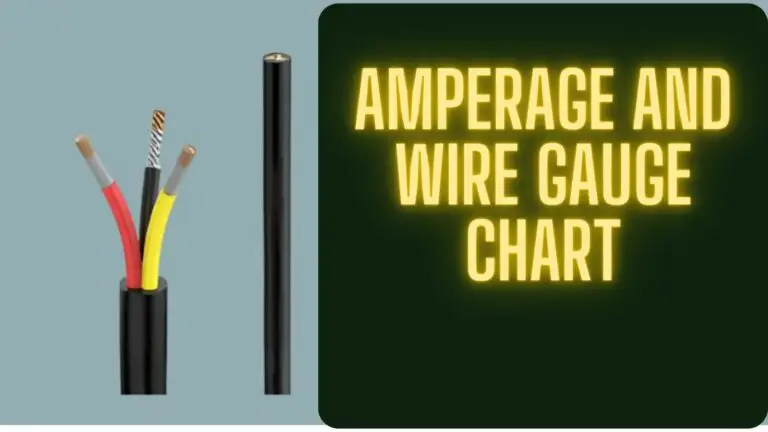
Amperage and Wire Gauge Chart: Understanding Electrical Wire Sizing
Electrical wiring is a vital aspect of any building’s infrastructure, from residential homes to industrial facilities. Choosing the correct wire size, also known as wire gauge, is essential to ensure safe and efficient electrical installations. The relationship between amperage (current) and wire gauge plays a significant role in determining the appropriate wire size for different electrical applications. Let’s delve into the importance of wire gauge and amperage, as well as how to use an amperage and wire gauge chart effectively.

Do I Need to Ground My Generator When Camping?
When venturing into the great outdoors for a camping trip, many outdoor enthusiasts opt to bring along generators to power their appliances and devices. While generators can provide a convenient source of electricity in remote locations, it’s essential to consider safety measures, including whether grounding the generator is necessary. In this article, we will talk about do I need to ground my generator when camping.
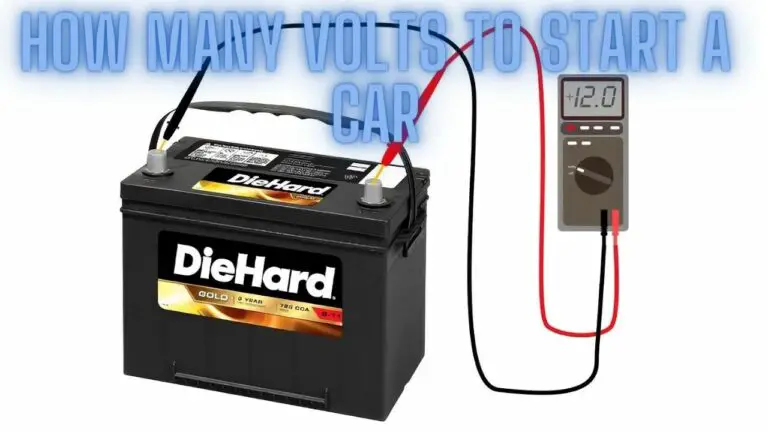
How Many Volts To Start A Car: Checking the Car Battery Voltage
The ability to start a car with a simple turn of the key or a push of a button is something many of us take for granted. However, behind this seemingly effortless action lies a crucial factor: voltage. Understanding the role of voltage in starting a car is essential for maintaining a healthy battery, a functional ignition system, and a reliable vehicle. In this article, we’ll explore how many volts are required to start a car and the factors that contribute to a successful ignition.

Generator For Welding Machine | What Size Generator For Welding?
Welding is a vigorous metal joining technique that necessitates a high voltage and current supply. As a result, many welding projects must be completed indoors, in a workshop or garage with a steady electric power source. It enables the welder to complete the work without fear of running out of power or underperforming the weld due to a disruption in the power supply. We will discuss Generator for Welding Machine thoroughly in this article.
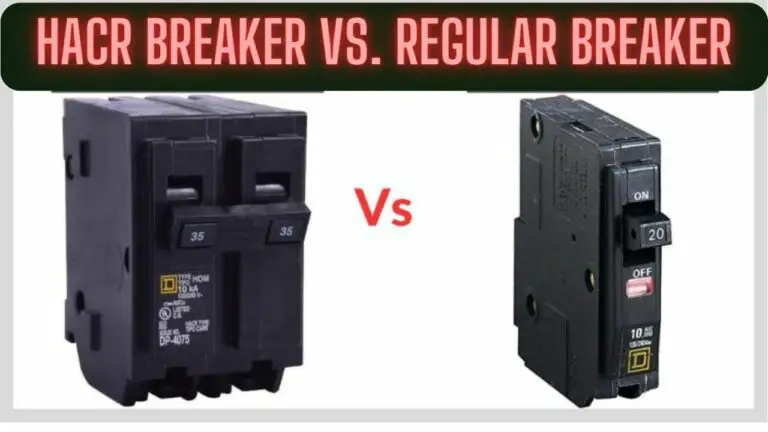
HACR Breaker vs. Regular Breaker: Understanding the Difference
Circuit breakers are essential components in electrical systems, serving as safety devices that protect circuits from overloads and short circuits. When it comes to circuit breakers, you might come across terms like “HACR breaker” and “regular breaker.” These terms refer to specific types of breakers designed for different applications. In this article, we’ll delve into the differences between HACR (Heating, Air Conditioning, and Refrigeration) breakers and regular breakers, their purposes, and where they are commonly used.

Common Solar Panel Problems: Troubleshooting and Solutions
Solar panels have revolutionized the way we harness renewable energy from the sun, providing a sustainable and environmentally friendly power source. However, like any technology, solar panels can encounter issues over time. In this article, we’ll explore some of the most common solar panel problems, their potential causes, and the steps you can take to troubleshoot and resolve these issues.
Leave a Reply Cancel reply
Your email address will not be published. Required fields are marked *
Save my name, email, and website in this browser for the next time I comment.

Home » circuit breaker » Shunt trip breaker
Shunt Trip Breaker: How It Works to Trip a Circuit Breaker.
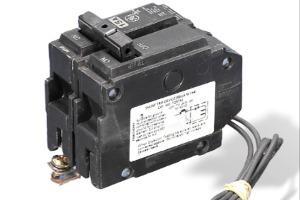
While circuit breakers protect appliances from power surges , shunt trip breakers add more protection to our electrical system and equipment .
If you are looking to add additional protection to your home circuit, or even trip your breaker remotely from your comfort zone, why not shop for a shunt trip circuit breaker?
Table of Contents
What is a shunt trip breaker?
A shunt trip device is an optional accessory for breakers that allows you to trip a circuit breaker with a remote, or automatically trip the switch during electrical surge or short circuit .
Shunt trip breakers are mostly used in commercial and industrial applications to enhance safety and protection of electrical appliances.
Types of shunt trip breakers
There are two main types of shunt trip circuit breakers they include.
- Automatic shunt trip breakers: These breakers trip automatically when they detect an electrical fault such as an overcurrent or a fire alarm.
- Manual shunt trip breakers: These breakers are tripped manually by pressing the remote button.

How the shunt trip circuit breakers work
A shunt trip breaker works like other circuit breakers . However, it comes with a solenoid coil which is connected to a separate control circuit.
When the control circuit is energized due to electrical fault or overload, it creates a magnetic field around the solenoid coil, which pulls a plunger inward.
This plunger is connected to the tripping mechanism of the circuit breaker. So when it is pulled inward, it trips the breaker and cuts off the power source.
Alternatively, a shunt trip breaker can also work with a remote control so you can trip the breaker remotely when there are electrical hazards
Where are shunt trips required
Shunt trip circuit breakers are used in various applications such as
- Industrial machines to protect it from damages that may arise from electrical faults.
- Fire protection systems to automatically shut off electrical power in the event of a fire outbreak.
- in commercial buildings for additional protection against electrical damage.
- hospitals and healthcare facilities to protect hospital equipment from electrical damage.
Advantages of using a shunt trip breaker
There are several advantages to using a shunt trip devices, these include:
- Enhanced Safety: It provides an additional layer of safety by quickly tripping the main breaker in the event of a fault or overload, preventing potential damage to electrical equipment.
- Remote tripping capability: A shunt trip breaker usually comes with a remote control to enable you to turn off the breaker at any needed time.
- Protection of sensitive equipment: It can help protect sensitive electrical equipment from power surges caused by overload or faults, ensuring the durability of the equipment.
Shunt trip breaker wiring

Before you wire a shunt trip, there are some things you will need to know.
Shunt trip is an accessory and is not compatible with all breakers. Some breakers come with an in-built shunt trip, others require specific models, or to be installed in the factory. Therefore, it is necessary that you evaluate all these before the wiring .
If the breaker is compatible with the shunt trip device, you can then follow this wiring diagram to install it.
Based on the MCCB shunt trip breaker wiring diagram above, the 3-phase 4-wire system from supply is connected to the mccb breaker .
The neutral wire is connected to the shunt coil, and the control line wires to the EPO button.
Difference between a shunt breaker and a GFCI
A shunt trip and a ground fault circuit interrupters (GFCI ) are both electrical devices , however, they are designed to work in different ways and for different purposes.
Below are their major differences.
When to call an electrician
If you have any issues with your electrical system, or went us to help you with a quotation or any wiring advice, contact us as we are here for you.
About mariaelectricals
Hi, I am Emmanuel Nwankwo, a commercial electrician and the founder of mariaelectricals.com . I established this blog to share my decades of work experience in electrical installations and repairs.

- Electrical Repair
- Lighting Installation
- Hot Tub Wiring
- Emergency Electrical Service
- Ceiling Fan Installation
- Generator Installation
- Commercial Lighting Services
- Electrical Inspection
- What Is a Shunt Trip Breaker and How Does It Work
What Is a Shunt Trip Breaker and How Does It Work?
First things first: what is a shunt trip breaker? A shunt trip breaker is a specialized circuit breaker that is designed to remotely shut off power to a circuit in emergency situations, such as a fire or security breach. These breakers are commonly used in commercial and industrial buildings, as well as other facilities where safety is a top priority. In this article, we'll explore this type of breaker in detail and explain why hiring an electrical services provider for a wiring shunt trip breaker is essential.
The Many Benefits of a Shunt Breaker
Let’s recap: a shunt trip breaker is an electrical component connected to a circuit breaker and allows for remote operation through a schematic and AMP connection. Now that you know what a shunt trip circuit breaker is, it's time to move to the next part of this article: the benefits of using a shunt breaker.
- Remote Shut-Off: One of the main benefits of shunt breakers is that they can be remotely shut off in the event of an emergency. This allows them to quickly and easily disconnect power in a fire or other emergency, which can help prevent damage to the building and protect the occupants.
- Increased Safety: Besides remote shut-off, shunt trip circuit breakers provide an added level of safety and security by automatically shutting off power to a circuit in the event of an emergency. This helps prevent electrical fires and other hazards, protecting both people and property.
- Easy Installation: Shunt breakers are relatively easy to install and can be integrated into existing electrical systems, making it possible to retrofit older buildings with these devices.
- Cost-Effective: A shunt breaker is a cost-effective solution for increasing safety and security in commercial and industrial buildings. They are relatively inexpensive to purchase and install and can help prevent costly damage to the building and its contents in case of any emergency.
- Compatibility: Shunt breakers are compatible with a wide range of electrical systems and devices, making them a versatile and practical solution for increasing safety in various settings.
How Does a Shunt Trip Breaker Work?
A shunt trip breaker works by tripping the breaker when it receives a signal from an external device, such as a fire alarm or security system. This helps to prevent dangerous electrical fires or other hazards. When an emergency occurs, the external device sends a signal to the breaker, which causes the breaker to trip and open the circuit, interrupting the flow of electricity and preventing power from reaching the circuit, allowing for a quick and easy power disconnection.
Types of Shunt Trip Breakers
Now that you know the answer to "How does a shunt trip breaker work", it's time to discover about the two main types of shunt trip breakers.
- Manual Shunt Trip Breaker: This type of trip breaker requires manual intervention to reset the breaker after it has been tripped, meaning someone must physically go to the breaker and reset it after an emergency situation. This breaker is typically used in smaller residential buildings or situations where a dedicated staff member is available to reset the breaker.
- Automatic Shunt Trip Breaker: This type of breaker can automatically reset itself after being tripped and is typically used in larger buildings or in situations where there is not always someone available to reset the breaker. These breakers are often connected to fire alarm systems or other emergency management systems for auto-reset.
When is a Shunt Trip Breaker Required?
If you're wondering when is a shunt trip breaker required, know that it is required in any electrical system where there is a need to quickly and easily shut off power in the event of an emergency, such as a fire or security breach. Continue reading as we describe the importance of using shunt trip breakers and how to figure out which one you need to use for your building or facility.
The Importance of Using a Shunt Trip Breaker
- Shunt trip breakers automatically shut off power in emergencies.
- They prevent dangerous electrical fires and other hazards.
- They allow for quick and easy power disconnection in emergencies.
- They are easy to install and cost-effective solutions for increasing safety.
- They can be connected to fire alarm and emergency management systems.
- They ensure that the electrical system is in compliance with safety regulations.
- They are a versatile and practical solution for increasing safety in various settings.
Which Type of Shunt Trip Breaker to Use?
A manual breaker may be appropriate for a smaller building or in situations with a dedicated staff member available to reset the breaker, while an automatic breaker may be more appropriate for a larger building or in situations where someone is not always available to reset the breaker. Another option to consider is the use of a shunt trip relay, which can be used to trigger a shunt trip breaker remotely. These relays are typically connected to fire alarm systems or other emergency management systems and can send a signal to the breaker to trip it when an emergency occurs.
Shunt Trip Breaker Wiring Diagram
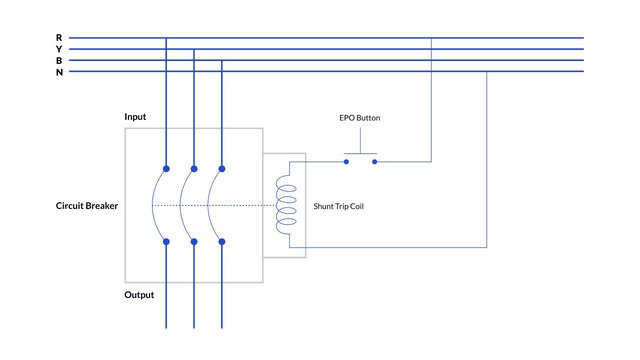
If you're wondering how to wire a shunt trip breaker, know that wiring can seem like a daunting task, but with the right knowledge and tools, it can be done relatively easily. Follow the steps below:
- Obtain a "How to wire a shunt trip breaker wiring diagram." (Check above).
- Gather necessary tools and materials such as wire strippers, nuts, and a voltage tester.
- Disconnect the power and wire the shunt breaker according to the instructions provided.
- Reconnect power to the circuit and test the breaker to ensure it works properly.
It is important to pay close attention to the diagram and follow the instructions carefully. This will ensure that the breaker is wired correctly and functions. Once the wiring is complete, you can reconnect the power to the circuit and test the breaker to ensure that it is working properly. It is always better to consult with a professional if you aren't confident about the wiring process.
What Does a Shunt Trip Breaker Do?
We hope by now you know what does a shunt trip breaker do, but here's a recap: a shunt trip breaker is a specialized circuit breaker that protects your house electrical systems from damage or hazards in emergencies. It works by tripping the breaker when it receives a signal from an external device, such as a fire alarm or security system, preventing dangerous electrical fires or other regular hazards.
Nevertheless, it is important to understand what does shunt mean in electrical terms and the role of electrical shunt trip breakers in commercial and industrial settings. Finally, to determine the appropriate type of breaker for your specific needs, it is best to consult an electrical services provider. If you're based in Colorado or surrounding areas, McCarrick Electric has got you covered.
Superior Electrical Solutions in Colorado
At McCarrick Electric, we have 25+ years of experience providing top-quality electrical services in Colorado. We value all of our customers, and that's why we offer a 15% discount for first-time residential clients and veterans. We take pride in our integrity, attention to detail, and cost-effectiveness. For more information, connect with us via our contact form or give us a call.
Latest Blog Entries

What to Do If Your Circuit Breaker Keeps Tripping?

Why Is Your Breaker Box Outside House? Here Are the Reasons
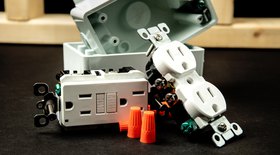
Why Won’t My GFCI Outlet Reset? How to Troubleshoot a GFCI Outlet

5 Ways to Prevent Short Circuits

Wire A Shunt Trip Breaker: Your Step-by-step Visual Guide
In the world of electrical engineering , dances with complex equipment are common. Few dances are as intricate as the one with the shunt trip breaker. As seasoned professionals, we guide you through this delicate ballet, ensuring your safety and the seamless operation of your electrical system.
Our comprehensive visual guide will demystify shunt trip breaker wiring, breaking down the process into manageable steps. By the end of this journey, you’ll possess the knowledge and skills to wire a shunt trip breaker with confidence.
First, let’s explore what a shunt trip breaker is and why it’s a crucial component in an electrical system.
Key Takeaways
- Shunt trip breakers are crucial in industrial settings and high-risk areas to prevent electrical fires and other hazards.
- The wiring diagram of a shunt trip breaker allows it to receive a signal from a separate source for immediate shutdown.
- The key parts of a shunt trip breaker include the coil, breaker mechanism, and trip unit, which work together to cut off power in case of overloads or faults.
- Proper installation and regular maintenance of shunt trip breakers are essential for ensuring system safety and efficiency.
Understanding the Importance and Functionality of Shunt Trip Circuit Breakers
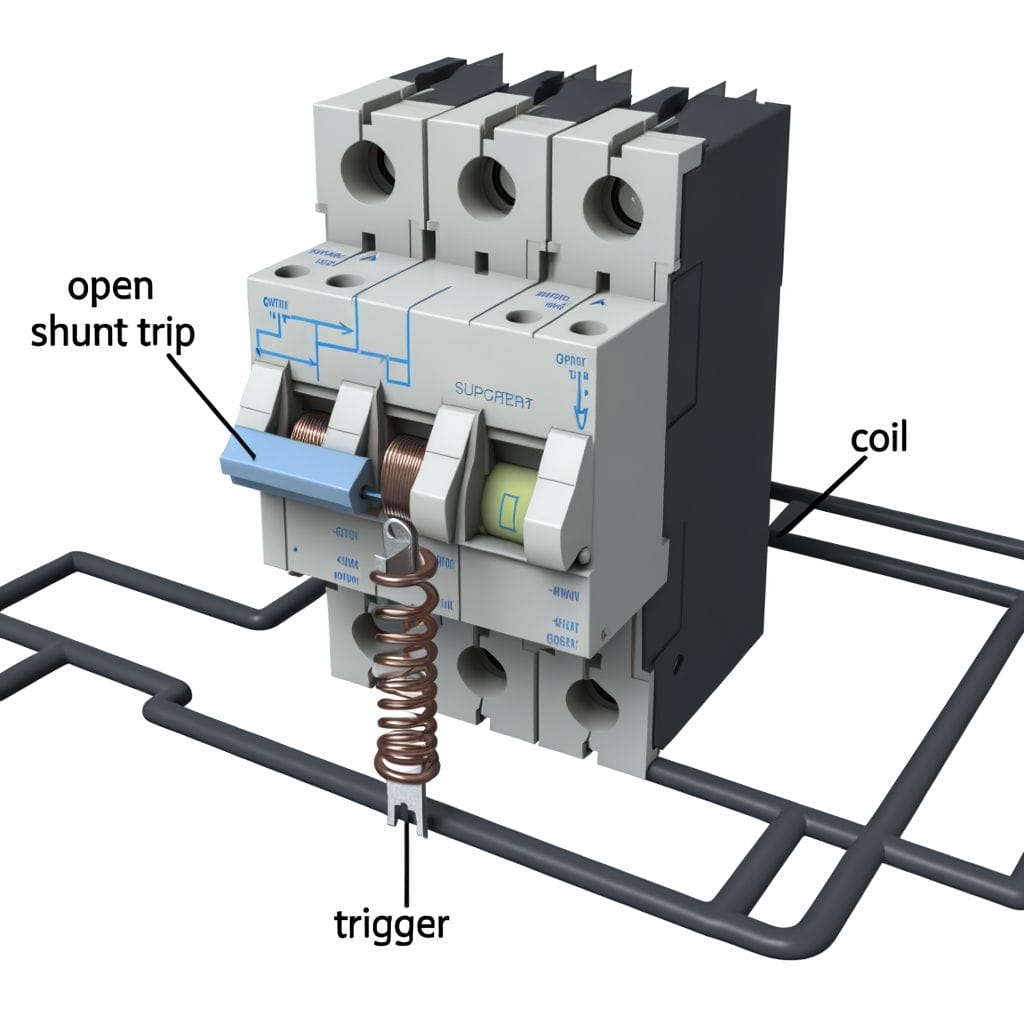
Diving into the heart of our discussion, it’s crucial to understand just what a Shunt Trip Circuit Breaker is. This innovative device shuts off an electrical circuit when it detects a problem, such as an overload or short circuit . This proactive functionality greatly reduces the risk of electrical fires and other potential hazards.
Its unique design allows the breaker to receive a signal from a separate source that triggers an immediate shutdown when necessary. This feature is particularly beneficial in environments where immediate circuit disconnection is paramount, like in industrial settings or high-risk areas.
Precision is key when installing a shunt trip breaker. A wrongly connected wire can compromise the breaker’s functionality, possibly leading to a dangerous situation. So, we strongly recommend professional installation to ensure the safety and efficiency of your electrical system.
Learning the Basics: Diagrammatic Representation of a Shunt Trip Breaker

To grasp the workings of a shunt trip breaker, let’s delve into its diagrammatic representation. A shunt trip breaker is comprised of key parts like the coil, the breaker mechanism, and the trip unit. These parts work together to safely distribute electricity and prevent dangerous overloads.
The current first enters through the coil. When an electrical fault is detected, the coil becomes energized, triggering the trip unit. This in turn activates the breaker mechanism, causing the breaker to trip and cut off the power. It’s a simple and efficient system and serves as an innovative solution for electrical safety.
Detailed Steps to Wire a Shunt Trip Breaker Safely and Efficiently
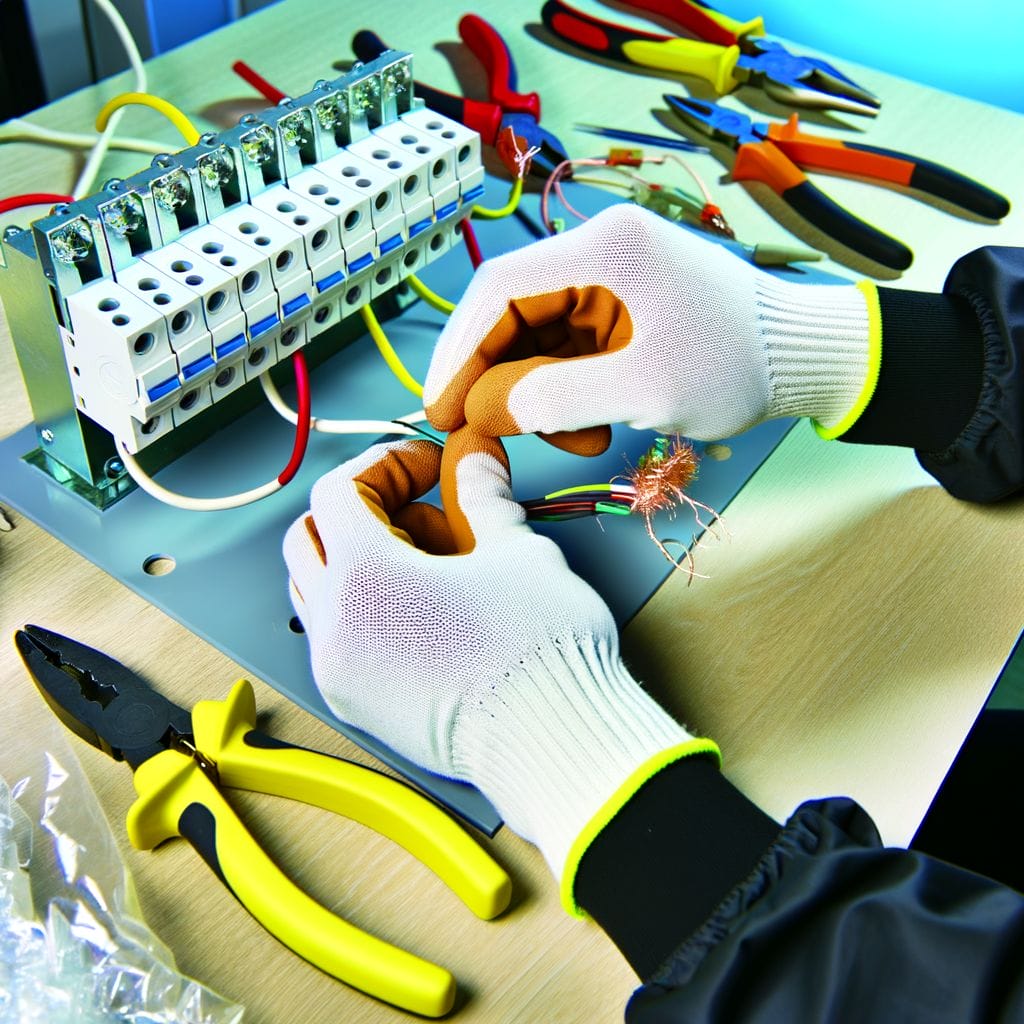
Ready to wire a shunt trip breaker? Start by preparing your workspace. Clear the area of any debris and make sure you have good lighting . Assemble your tools, which include a screwdriver, wire stripper, and multimeter.
Once your workspace is ready, follow the step-by-step process. Start by turning off the main power supply. After that, connect the shunt trip breaker to the circuit. Be sure to connect the wires correctly: the black wire to the breaker terminal, the white neutral wire to the neutral bus bar, and the green or bare ground wire to the ground bus bar.
Avoid common pitfalls like loose connections and incorrect wiring. Always double-check your work to ensure everything is wired correctly.
Connecting the Shunt Trip: An Essential Accessory for System Safety

A functioning shunt trip breaker represents an innovative approach to electrical safety. It automatically cuts power in the event of an electrical anomaly, shielding your system from damage. Hence, the importance of connecting the shunt trip can’t be overstated.
To wire a shunt trip breaker, we must employ a methodical approach. Connect the shunt trip coil to the breaker’s auxiliary terminal. Secure the connection using the recommended fasteners. Always test the shunt trip breaker to ensure it operates correctly and inspect the connection regularly for ongoing safety.
Troubleshooting Tips: Ensuring a Reliable Shunt Trip Breaker Connection
Even with careful installation, occasional challenges may arise in the wiring of a shunt trip breaker. To empower you further, let’s delve into troubleshooting tips for maintaining a reliable connection.
- Faulty Connections : If the shunt trip breaker isn’t functioning as expected, inspect the connections thoroughly. Ensure they are tight and secure. Reconnect any loose wires and tighten screws appropriately.
- Testing Procedures : Regularly test the shunt trip breaker using the recommended testing procedures. If the breaker fails to trip during a test, reassess the wiring and consult the manufacturer’s guidelines for troubleshooting.
- Voltage Issues : Check the voltage supply to the shunt trip breaker. Ensure it aligns with the specified requirements. Any discrepancies may affect the breaker’s performance. Consult a professional if voltage-related concerns persist .
- Visual Inspection : Periodically inspect the breaker for signs of wear, damage, or overheating. Replace any damaged components promptly. Visual cues can provide early warnings of potential issues.
- Interference and Environmental Factors : Assess the surrounding environment for potential interferences, such as electromagnetic interference or extreme temperatures. Shield the breaker from external factors that could compromise its functionality.
By familiarizing yourself with these troubleshooting techniques, you can address issues promptly, ensuring a reliable and efficient shunt trip breaker connection. Remember, a well-maintained breaker contributes significantly to the overall safety and reliability of your electrical system.
Are the Wiring Steps for a Shunt Trip Breaker Similar to a Water Well Pressure Switch?
No, the wiring steps for a shunt trip breaker are not similar to a water well pressure switch. While both involve wiring, the purpose and functionality of each are different. In the case of a shunt trip breaker, the wiring process will be specific to its functionality and requirements, and would not be interchangeable with water well pressure switch wiring .
In wrapping up, we’ve guided you through the crucial steps of wiring a shunt trip breaker. We trust you now understand its importance and how it operates.
With safety as our primary concern, we’ve shown you the right way to connect the shunt trip. Remember, knowledge is power, and this guide arms you with the needed expertise.
Keep exploring our guides for more practical electrical tutorials. Your safety and satisfaction are our top priorities.
Frequently Asked Questions
What is a shunt trip breaker.
A shunt trip breaker is a type of circuit breaker that can be triggered remotely to trip the breaker. It is frequently used in commercial kitchens, elevators, and other applications where the breaker needs to be tripped manually or remotely in case of an emergency.
Can you explain the shunt trip breaker wiring diagram?
The shunt trip breaker wiring diagram shows the connections for the shunt trip terminals, control circuit, and external power source. It also illustrates how the breaker is typically wired to trip the circuit breaker remotely or automatically during a surge or in case of an emergency such as a smoke alarm.
What is the purpose of a shunt trip breaker?
The main purpose of a shunt trip breaker is to provide circuit protection and to trip the breaker remotely or automatically during a surge, alarm, or emergency situation. It can help minimize equipment damage and ensure the safety of the electrical system.
How does a shunt trip breaker work?
A shunt trip breaker works by using an electromagnet to trip the breaker when it receives a signal from the control circuit. This can be done manually, through a relay, or remotely depending on the particular shunt trip accessories and model of the breaker.
What are the components of a shunt trip breaker?
A shunt trip breaker includes the main circuit breaker, shunt trip terminals, external power source, control system, and the shunt trip accessories. These components work together to trip the breaker manually or remotely in case of an emergency.
Similar Posts

Living Room Ambient Lighting: Create a Cozy Home Feel
Creating a warm and inviting atmosphere in your living room relies on strategic ambient lighting. Not only is…

Is 24 Volts Dangerous? Understand the Risks of High Voltage
As we explore the domain of electrical systems, the question of whether 24 volts can be hazardous warrants…

LED Lighting for Game Room: Enhance Your Gaming Experience
Upgrade your game room with LED lighting! Learn how it can boost your gaming fun. Explore adjustable brightness,…

5 Best Small Grow Lights: Compact Solutions for Plant Growth
When selecting the Best Small Grow Lights for your indoor plants, pay attention to efficiency, spectrum range, and…

5 Best Outdoor Commercial Solar Lights: Efficient Lighting
Illuminate your commercial space efficiently with the best outdoor solar lights! Discover top-rated options tailored for commercial use,…

LED Light Anode and Cathode: Understanding the Core of LEDs
The anode and cathode are the life force behind the glow of LED lights, much like the heart…

¿Cómo funciona un shunt de corriente?
Descubre qué es un shunt de corriente, cómo funciona, sus tipos, aplicaciones y cómo elegir el correcto para tus necesidades.
¿Qué es un Shunt de Corriente?
Un shunt de corriente es un dispositivo que se utiliza en la medición eléctrica para desviar corrientes de un circuito principal a través de una ruta alternativa. La función principal del shunt de corriente es convertir la corriente en un voltaje que se puede medir fácilmente, permitiendo así realizar mediciones precisas sin interrumpir el flujo de corriente en la aplicación principal.
Principio de Funcionamiento del Shunt de Corriente
El principio básico detrás de un shunt de corriente es la ley de Ohm, que establece que la corriente que pasa por un conductor entre dos puntos es directamente proporcional al voltaje a través de los dos puntos. En términos sencillos, un shunt de corriente funciona colocando una resistencia de precisión conocida (el shunt) en paralelo con el dispositivo o el componente que se va a medir. Parte de la corriente fluye a través del shunt y el resto continúa a través del circuito principal.
La cantidad de corriente que fluye a través del shunt genera una caída de voltaje proporcional a la resistencia del shunt, que puede ser medida. Esta caída de voltaje se usa entonces para calcular la corriente total en el circuito principal.
Tipos de Shunts de Corriente
- Shunts de baja corriente: Estos se utilizan para medir corrientes inferiores a 1 A. Son pequeños y generalmente se montan directamente en los terminales de los medidores.
- Shunts de alta corriente: Estos se utilizan para medir corrientes superiores a 1 A y pueden soportar corrientes de hasta varios miles de amperios. A menudo, están construidos para ser montados en la base o en un carril DIN y pueden venir con una caja de protección para asegurar su seguridad.
Aplicaciones del Shunt de Corriente
- Se utilizan en los medidores de corriente para medir la corriente en un circuito eléctrico.
- Son útiles para proteger los circuitos eléctricos, ya que pueden derivar la corriente en caso de una sobrecarga.
Factores a tener en cuenta al seleccionar un Shunt de Corriente
Hay varios factores que debes tener en cuenta al seleccionar un shunt de corriente para tu aplicación:
- Rango de corriente: Debes seleccionar un shunt que pueda manejar el rango de corriente que se va a medir.
- Precisión: La precisión de un shunt es importante para garantizar mediciones exactas. Los shunts suelen tener una precisión de 0,5% a 1%.
- Condiciones ambientales: Debes considerar las condiciones ambientales en las que operará el shunt, como la temperatura, la humedad y el grado de vibración.
En resumen, un shunt de corriente es un dispositivo esencial en la medición eléctrica que permite convertir la corriente en un voltaje medible. A través de su diseño basado en la ley de Ohm, un shunt de corriente puede derivar una porción de la corriente de un circuito principal a una ruta alternativa, permitiendo mediciones precisas de la corriente sin interrumpir el funcionamiento del circuito principal.
Los shunts de corriente son fundamentales en una variedad de aplicaciones, desde la protección de circuitos eléctricos hasta la medición precisa de la corriente. Al seleccionar un shunt de corriente, es esencial considerar factores como el rango de corriente, la precisión y las condiciones ambientales para garantizar que se adapte a tus necesidades específicas.
Así que la próxima vez que necesites medir la corriente en un circuito eléctrico, recuerda: un shunt de corriente puede ser la solución que necesitas.
Related Posts:

The primary purpose of this project is to help the public to learn some exciting and important information about electricity and magnetism.
Privacy Policy
Our Website follows all legal requirements to protect your privacy. Visit our Privacy Policy page.
The Cookies Statement is part of our Privacy Policy.
Editorial note
The information contained on this website is for general information purposes only. This website does not use any proprietary data. Visit our Editorial note.
Copyright Notice
It’s simple:
1) You may use almost everything for non-commercial and educational use.
2) You may not distribute or commercially exploit the content, especially on another website.

- Aerospace actuators and motion control
- Back-up power, UPS, surge & IT power distribution
- Clutches and brakes
- Conduit, cable and wire management
- Differentials and traction control
- Ducting solutions
- Electrical circuit protection
- Electric vehicles and EV charging
- Electronic components
- Energy storage systems
- Engine solutions
- Filtration solutions
- Fuel systems, emissions and components
- Hose, tubing, fittings & connectors
- Industrial controls, drives, automation & sensors
- Lighting and controls
- Low-voltage power distribution & control systems
- Medium-voltage power distribution & control systems
- Motors & generators
- Process safety, automation, test and measurement
- Product Overview
- Residential
- Safety, security & emergency communications
- Server racks, enclosures and airflow management
- Steering systems
- Support systems
- Transmissions
- Utility & grid solutions
- Vehicle controls, automation & power management
- Wiring devices & connectivity
- Digital overview
- Explore our digital catalogue
- Discover Brightlayer
- Understanding Industry 4.0
- For developers
- Marketplace
- Data centers
- Food & beverage
- Machine building
- Markets Overview
- Mining, metals & minerals
- Oil & gas

- Business resources
- Contact technical support
- Eaton Canada Locations
- International Support Contacts
- POWEREDGE support
- Product announcements
- Support overview
- Terms and conditions
- Training and education
- Warranty and returns

- News & insights
- Investor relations
- Sustainability
- Inclusion & diversity
- Ethics & compliance
- Selling to Eaton
- Partnering with Eaton
- Shunt trip safety switches
Eaton’s shunt trip safety switches, unique to the market, provide remote switching and a visible means of disconnection for commercial and industrial applications. In addition, the shunt trip technology enhances safety by providing the means to open a safety switch electronically. This product line provides additional code-compliant solutions with optional protection schemes such as arc energy reduction (NEC 240.67) and ground fault (including 480 VAC and 1200A service entrance applications).
- Locate a distributor

Photo is representative
Core features
- Standard heavy-duty safety switch design with integrated shunt trip module
- Integral arc energy reduction system available (NEC 240.67)
- Integral ground fault protection available for 480 VAC service entrance applications (NEC 230.95)
- Works with emergency-stop push buttons and other remote signalling means to quickly disconnect power from equipment
- Provides a safety-switch solution for oil and gas, industrial plants, utilities, commercial construction and water and wastewater treatment applications
- Includes two, three and four-pole configurations for maximum system voltages of 600Vac with fusible and non-fusible protection options
- Meets the Underwriters Laboratories (UL) standards and is listed to UL98 standard
- Provides a variety of coil voltages, visible means of disconnection and a standard, heavy-duty safety switch with integrated shunt trip module
- Passes Class 1 ground fault testing (1200% opening)
- CSA certified
View design guide (layouts, technical data and application information)
Download guide spec (26 28 16 13), find out about power system design basics, switching device flex centre.
Eaton’s custom-modification facility that meets the unique product needs and specifications of the customer
Switching devices
Discover how Eaton’s switching device product line brings state-of-the art, safe designs that can even be customised to fit your unique needs.
Advancing personnel and equipment protection with safety switches
The evolution of safety switch technology and a growing emphasis on personnel protection.
Switch portfolio
Related products.
Pringle bolted pressure contact switches
Heavy-duty, quick-connect safety switches
Renewable energy safety switches
- Alpha: A to Z
- Alpha: Z to A
- Specifications
Maximum reached
Four is the maximum number of items in the comparison tool.
Two items are required
A minimum of two items are required to use the comparison tool.
Something went wrong
Sorry, we can't get that information right now.
- Safety switch catalogue configurator Download The Safety Switch online configurator helps build custom solutions as per the project requirements. (PDF 1 MB, 10/06/2021)
- Safety Switches: One stop solution Download Counter mat with complete line of safety switches (PDF 1 MB, 10/06/2021)
- Switching device family line card Download The solution for your customization needs (PDF 8 MB, 08/09/2021)
- Switching Devices Download Safety Switches (PDF 26 MB, 06/05/2021)
Design guides
- Safety switches design guide Download This design guide provides dimensions, layout examples, technical specifications and application information for low-voltage safety switches. The information in this document supersedes section 28 of the Consulting Application Guide (CAG). (PDF 1 MB, 08/09/2021)
Infographics and listicles
- Switching devices flex center infographic Download This document highlights the capabilities of Eaton’s Flex Center which provides custom solutions for safety switches, enclosed circuit breakers and rotary disconnects. (PDF 141 KB, 01/10/2015)
Manuals and user guides
- Safety switch renewal parts Download This renewal parts guide reviews Eaton's general duty and heavy-duty safety switch renewal part availability. (PDF 466 KB, 30/01/2024)
Technical data sheets
- Arc energy reduction relay switching devices product platforms Download Updated This document contains technical details for arc energy reduction relay switching devices product platforms. (PDF 1 MB, 17/04/2024)
- Safety Switch Fine Strand Wire Guidelines Download Fine stranded wire guidelines for use with Eaton's General Duty, Heavy Duty, Double Throw and Elevator Control switches (PDF 271 KB, 11/07/2022)
- Switching Device Replacement Parts Guide Download Safety Switches, Pringle Switches and Enclosed Rotary Switches (PDF 568 KB, 10/06/2021)
- Switches, disconnects and enclosed breakers

- Inclusion and Diversity
- News and insights
- Slavery and human trafficking statement
- Policies and statements
- Responsible sourcing of conflict minerals
- Subscribe to emails
Let's talk big ideas
- Privacy, cookies & data protection policy
Escuela de reparación electrónica
Resistencias shunt. Qué son, cómo funcionan, y por qué debes conocerlas
Las resistencias shunt son resistencias normales, que se usan para medir la corriente de forma indirecta.
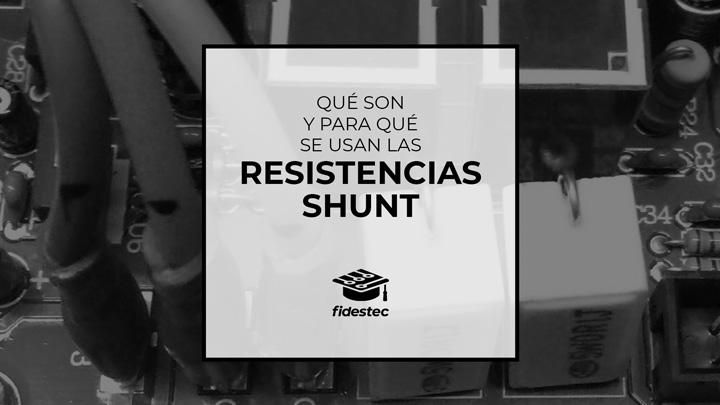
Es decir, a partir de la tensión que hay en sus extremos, se puede calcular fácilmente la corriente que la atraviesa con una sencilla ley de Ohm.
Esto es muy útil en muchos tipos de circuitos electrónicos, donde resulta complejo colocar un amperímetro.
También en placas basadas en microcontroladores, donde las entradas solo pueden medir tensión.
Este tipo de componentes se encuentra en muchos equipos de electrónica de potencia y fuentes de alimentación.
Sin embargo, a pesar de lo simple de su funcionamiento, recibo muchas consultas sobre ellas.
Parece que no queda claro cómo identificarlas, o cómo saber si estamos viendo resistencias shunt y otra cosa.
Creo que la principal causa de esta confusión es que hablamos de resistencias normales.
Puede usarse cualquier tipo de resistencia en modo shunt
Hay ciertas características especiales, en función del circuito donde se encuentren montadas.
Por ejemplo, son resistencias con bajo valor óhmico, es decir con valores menores a 1 ohmio (Ω).
También, cuando se trata de circuitos de cierta potencia, las resistencias shunt deben ser mayores, para soportar corrientes más elevadas.
En el vídeo te cuento con detalle cómo funcionan:
También te cuento cosas que no he dicho en el vídeo.
Por ejemplo, que cuando se manejan corrientes más importantes de los que pueden soportar las resistencias comunes, se usan tipos especiales:
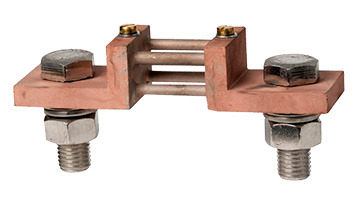
Aunque parezcan otra cosa, simplemente son resistencias que se usan para medir corriente.
Si te fijas en la imagen, los tornillos grandes son para conectar los cables principales (quedando en serie con el circuito a alimentar).
Los tornillos pequeños son para conectar los hilos que van al voltímetro, o al equipo de medida correspondiente.
Otras variaciones comunes, consisten en conectar varias resistencias en paralelo.
Con esto se consiguen varias ventajas, pero se genera un inconveniente:
Las ventajas son:
- Se pueden conseguir valores más exactos, por ejemplo si necesitas 0,33Ω, puedes usar tres resistencias de 1Ω.
- La corriente se reparte, generando menos calor, y por lo tanto pudiendo usar resistencias menos voluminosas.
- Puedes combinar resistencias de valores comunes para obtener un valor total que no esté normalizado.
El principal inconveniente, es que si una de las resistencias se daña, el valor medido será incorrecto, pudiendo provocar una avería en cadena.
Tu experiencia con resistencias shunt
Creo que te he contado bastantes detalles de estos componentes electrónicos.
Ahora te toca a ti.
Déjame tu comentario aquí debajo, y cuéntame si alguna vez te has encontrado uno de estos tipos extraños de resistencia shunt.
O si te has confundido alguna vez al identificarlas, y cómo lo has resuelto.
También dime si quieres que hable más de este tema, o proponme nuevas ideas.
Gracias a ti puedo llegar a más gente, así que puedes ayudarme compartiendo este artículo en tus redes sociales.
También puedes suscribirte para no perderte ninguna publicación , y llevarte además un regalo.
Nos leemos en el próximo!!
Acerca de Eugenio Nieto
Reparo y enseño cómo reparar averías. Puedes copiar mis técnicas para mejorar en tu trabajo. Apúntate para recibir mi correo contándote cosas cada día que no publico en ningún otro sitio:
Recibir correo
Recibe más en tu correo
Apúntate para recibir mi email diario contándote cosas interesantes sobre reparación, que no publico en ningún otro sitio. Empiezas a recibirlo mañana (nunca sabrás lo que escribí ayer)
Si no te gusta, un clic para borrarte.
También recibes (hoy) una clase en vídeo donde te muestro cómo identifico a simple vista las secciones de una fuente conmutada.
Comentarios
29/04/2021 a las 18:33
Hola: Gracias por la explicación. Tengo una duda. He comprado por internet una pequeño voltimetro amperimetro y por aquelo de “burro grande, ande o no ande” lo pedí que midiera hasta 50 A, por lo que viene con el shunt correspondiente aparte (los de hasta 10 A lo llevan integrado). Cual ha sido mi sorpresa que el shunt mide casi 12 cm de largo y 2 de ancho lo que me descoloca la posibilidad de integrarlo donde yo quería. ¿Existe la posibilidad de usar otra resistencia más pequeña o sería mejor pedir unos de los de hasta 10A, y limitar el circuito a esta corriente? Es para una fuente de alimentación para pequeños proyectos.
Eugenio Franco Montes dice
22/04/2021 a las 15:37
Buenos días Eugenio!
Consulta, una resistencia Shunt para medición de corriente en transformadores de potencia de 600 a 1000 kVA, cada cuantos años debería calibrarse? No encuentro la información por ningún lado y un proveedor me presenta certificados del 2018.
Mil gracias la página está muy completa!
Rodrigo dice
07/11/2020 a las 16:06
Hola me gustaría aclarar una duda, tengo una pequeña instalación fotovoltaica aislada compuesta por 3 paneles solares y 2 baterías conectadas en paralelo todo de 12v, las placas tienen un regulador solar MPPT y a la entrada de la batería hay un shunt en el negativo y aquí está el problema: el cable negativo que viene del regulador solar y llega a un polo del shunt llegan por ejemplo 3 amperios que coincide con lo que me indica el regulador solar que estaría cargando pero al pasar estos 3 amperios por el shunt a la batería solo le entrega 2 amperios y coincide con lo que me muestra la pantalla que viene con el shunt, lo que no entiendo es porque hay tanta diferencia al pasar por el shunt porque se pierde un porcentaje de la carga que entrega el regulador solar hacia las baterías? Perdón por el tocho espero haberme expresado bien. Gracias
Rodiberto dice
13/05/2020 a las 18:48
Disculpa me puedes ayudar. Yo llegue hasta aqui por que estoy haciendo un cargador de bateria para auto y quiero colocar un voltimetro amperimetro con resistencia shunt que me llego junto con el voltimetro que compre. Como seria la vonexion para que me de lectura el voltimetro amperimetro de la bateria a cargar (descargada) de antemano gracias
Eugenio Nieto dice
26/05/2020 a las 12:30
Es difícil de explicar, y mucho más fácil de ver con un esquema. Con el amperímetro que compraste te debería venir un esquema de conexión. Saludos.
26/04/2020 a las 19:03
HOLA EUGENIO.
ESTIMADO, LE FELICITO POR ESTA CAPACITACIÓN ACERCA DEL SHUNT.. LA VERDAD ESTE ERA UN TEMA CONFUSO PARA MI, POR COMO LO COMENTAS AL FINAL DEL VÍDEO, PERO GRACIAS A TU INFORMACIÓN ME HA QUEDADO CLARO PARA QUE SIRVE Y COMO SE PUEDE UTILIZAR…GRACIAS DESDE CHILE..EXITOOO
Victor dice
07/12/2019 a las 23:03
Como calcular las resistencia shunt? Ej. Dos baterias Litio en paralelo de 48 voltios 150ah para un total de 300ah.
migeca dice
03/09/2019 a las 14:49
Buenos dias. Me gustaria que hablaras de motores dc tipo shunt y sus conexiones. gracias
Erick aviila dice
25/07/2019 a las 03:22
Hola, saludos desde Mexicali,estoy checando un cargador de baterías y tengo un dispositivo al parecer un transductor TV 111 elko. A este le llega una tensión de 220 vac y tiene otras salidas que dicen + y – las cuales van conectadas a resistencias Shunt. Quisiera saber cómo trabaja entonces este transductor el cual dice en su descripción +- 60 mv
Jose Antonio Alvarez dice
21/11/2018 a las 14:51
Hola Para medir resistencias de bajo valor se hace circular una corriente constante y conocida y midiendo el voltaje en los extremos se calcula por ley de ohm. Es la forma mas facil y practica sin emplear instrumental especial y muy costoso. Se pueden medir resistencias de cualquier valor, aun los mas bajos. Gracias
Jose luis dice
20/11/2018 a las 23:52
Hola Eugenio , buen artículo sobre las resistencias Shunt.En foros de internet he leído compañeros que se fabrican sus propios circuitos para medir el valor de estas resistencias, ya que con los multimetros es prácticamente imposible, aunque sea de mucha calidad, y ya me ha salido el caso de probar una shunt en una fuente con un multimetro ( para tener una aproximación) y dándola por buena y al final estaba aumentada de valor, ese caso es frecuente. Nos podía explicar cómo construir un circuito para medir las shunt en su valor exacto ?
Fernando de Luis dice
20/11/2018 a las 22:00
Muy bueno el vídeo, el uso de la pizarra para explicar las cosas hace que sea muy fácil de entender lo que se explica, muchas gracias por tus vídeos son de mucha utilidad.
José Antonio dice
20/11/2018 a las 19:48
Muchas gracias.Un tema muy interesante. Cómo bien dices,con este tipo de resistencia podemos tener confusiones a la hora de ver cómo influye en el funcionamiento del circuito.
Alexander dice
20/11/2018 a las 14:33
Hola Eugenio. Gracias por compartir un tema muy interesante. Te agradeceré comentar la aplicación respeto a las resistencias Shunt que especifican 60mV,75mV y 100mV. Muchas gracias. Saludos. Alexander Parra.
Julian Valls dice
19/11/2018 a las 19:14
Un tema muy interesante y que vi un poco por encima en la asignatura de instrumentación en la universidad. Las Shunt aparte de para controlar la corriente en circuitos tendrian utilidades relacionadas con la protección? digo de forma directa. Gracias Eugenio, como siempre tocando temas de forma directa y con la teoria justa para poder empezar a identificar y resolver.
Deja una respuesta Cancelar la respuesta
Tu dirección de correo electrónico no será publicada. Los campos obligatorios están marcados con *
Comentario *
- Información básica sobre protección de datos
- Responsable: Eugenio Nieto Vilardell (Fidestec) [+info]
- Finalidad: Gestión de comentarios. Estadísticas de uso. Tu comentario será público y libre de derechos. Tu nombre, dirección web y avatar (si usas Gravatar, Google+ o algo similar enlazado con tu dirección de email) quedarán visibles a todos los visitantes de esta web. Comentar aquí no implica suscricpión a newsletter u otros servicios. [+info]
- Legitimación: Consentimiento del interesado. [+info]
- Destinatarios: Podrán cederse datos a empresas colaboradoras cuando sea necesario para prestar servicios solicitados, almacenamiento de datos, computación en la nube y obligaciones legales, dentro de la UE estando sometidas a normativas europeas de tratamiento de datos, y fuera de la UE bajo el amparo de “Privacy Shield”. Ninguna de estas empresas podrá usar tus datos para fines propios. [+info]
- Derechos: Tienes derecho a acceder, rectificar y suprimir los datos, así como otros derechos, como se explica en la información adicional. [+info]
- Información adicional: Puedes consultar la información adicional y detallada sobre protección de datos en https://fidestec.com/blog/legal/
Correo electrónico *
Recibe mi correo diario
Te apuntas y recibes un regalo ahora, y a partir de mañana un correo cada día (nunca sabrás lo que escribí ayer). Si no te gusta, en cada correo hay un enlace para borrarte con un clic y no volver a saber de mí. También te contaré cosas sobre mis productos y servicios, si no te gusta no te apuntes.
Motor en derivación (Motor Shunt): características y aplicaciones
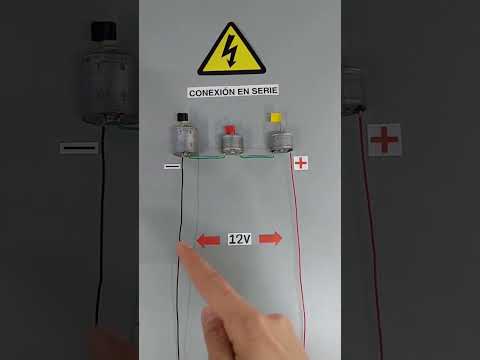
El motor en derivación, también conocido como motor shunt, es una de las configuraciones más comunes en la industria de la electrónica. Sus características y aplicaciones lo convierten en una opción versátil y eficiente para una amplia gama de aplicaciones. En este artículo, exploraremos en detalle las características de este tipo de motor y las diversas formas en las que se utiliza en diferentes industrias. Si estás interesado en conocer más sobre la tecnología detrás de los motores y su funcionamiento, sigue leyendo para descubrir todo lo que necesitas saber sobre el motor en derivación.
Dónde se utiliza el motor shunt
Características del motor shunt, aplicaciones del motor shunt, qué es el dinamo shunt y qué características tiene, qué diferencia hay entre un motor serie y un motor shunt, características del motor en derivación, aplicaciones del motor en derivación.
El motor en derivación, también conocido como motor shunt, es un tipo de motor eléctrico ampliamente utilizado en diversas aplicaciones debido a sus características únicas. En este artículo, exploraremos en detalle qué es un motor shunt, cómo funciona y dónde se utiliza en la práctica.
El motor shunt es un tipo de motor de corriente continua que se caracteriza por tener un devanado de campo en paralelo con el devanado del rotor. Esto significa que la corriente de campo y la corriente del rotor fluyen independientemente, lo que ofrece ciertas ventajas en términos de control y rendimiento del motor.
Una de las principales características del motor shunt es su velocidad constante a diferentes cargas. Esto se debe a que la velocidad del motor está determinada principalmente por la tensión aplicada, y esta tensión se mantiene constante a lo largo de la operación. Por lo tanto, el motor shunt es ideal para aplicaciones en las que se requiere una velocidad constante, como en la industria textil, la industria de alimentos y bebidas, y la automatización industrial.
Otra característica importante del motor shunt es su alta eficiencia. Este tipo de motor puede convertir la mayor parte de la energía eléctrica en energía mecánica, lo que lo hace muy eficiente en términos de consumo de energía. Esto es especialmente importante en aplicaciones donde se requiere un uso prolongado del motor, lo que ayuda a reducir los costos de energía a largo plazo.
El motor shunt se utiliza en una amplia gama de aplicaciones debido a sus características únicas. Algunas de las aplicaciones más comunes incluyen:
- Maquinaria industrial: El motor shunt se utiliza en maquinaria industrial, como bombas, compresores, ventiladores y generadores, donde se requiere una velocidad constante y un alto rendimiento.
- Elevadores y grúas: Debido a su capacidad para mantener una velocidad constante, los motores shunt son ampliamente utilizados en elevadores y grúas, donde se requiere un control preciso de la velocidad y la carga.
El motor en derivación, también conocido como motor shunt, es un tipo de motor eléctrico que se utiliza en una amplia variedad de aplicaciones. En este artículo, vamos a profundizar en qué es el dinamo shunt y cuáles son sus características más destacadas.
¿Qué es el dinamo shunt?
El dinamo shunt es un tipo de generador eléctrico que utiliza un campo magnético constante en paralelo a la armadura. Esto significa que tanto el campo magnético como la corriente de excitación son independientes de la corriente de carga. A diferencia de otros tipos de generadores, el dinamo shunt no depende del flujo de corriente en su campo magnético para generar electricidad.
Características del dinamo shunt
– Regulación de velocidad estable: Una de las principales características del dinamo shunt es su capacidad para mantener una velocidad de rotación estable incluso bajo carga variable. Esto se debe a que el campo magnético y la corriente de excitación permanecen constantes, lo que permite un control preciso de la velocidad del motor.
– Arranque suave: Gracias a su diseño, el motor shunt ofrece un arranque suave y gradual. Esto evita los picos de corriente y protege tanto al motor como a los dispositivos conectados a él.
– Amplio rango de velocidad: El dinamo shunt es capaz de operar en un amplio rango de velocidades, lo que lo hace adecuado para aplicaciones que requieren un control preciso de la velocidad, como en máquinas herramienta, bombas y ventiladores.
– Alta eficiencia: Este tipo de motor ofrece una alta eficiencia energética, lo que significa que convierte una mayor cantidad de energía eléctrica en energía mecánica. Esto resulta en un menor consumo de energía y un funcionamiento más económico.
Aplicaciones del dinamo shunt
El motor en derivación se utiliza en una amplia gama de aplicaciones, incluyendo:
– Máquinas herramienta: El dinamo shunt se utiliza en máquinas herramienta como tornos y fresadoras, donde se requiere un control preciso de la velocidad y una respuesta rápida a cambios de carga.
En el campo de la ingeniería eléctrica y la automatización industrial, existen diferentes tipos de motores utilizados para diversas aplicaciones. Uno de estos tipos es el motor en derivación, también conocido como motor shunt. En este artículo, exploraremos las características y aplicaciones de este tipo de motor.
El motor en derivación es un tipo de motor de corriente continua. Se caracteriza por tener dos devanados separados: el devanado de campo y el devanado de armadura. El devanado de campo está conectado en paralelo al devanado de armadura, de ahí su nombre «en derivación».
Una de las características distintivas del motor en derivación es su capacidad para mantener una velocidad constante bajo diferentes cargas. Esto se debe a que el devanado de campo y el devanado de armadura están conectados en paralelo, lo que significa que la corriente de campo no varía significativamente con cambios en la carga.
Además, el motor en derivación es conocido por tener un alto par de arranque. Esto significa que puede arrancar fácilmente y proporcionar un alto torque inicial, lo que lo hace ideal para aplicaciones que requieren un arranque suave y un control de velocidad preciso.
El motor en derivación se utiliza en una amplia variedad de aplicaciones debido a sus características únicas. Algunas de las aplicaciones comunes incluyen:
- Maquinaria industrial: El motor en derivación se utiliza en la industria para impulsar máquinas y equipos, como bombas, compresores y ventiladores.
- Generadores: El motor en derivación también se utiliza en generadores para convertir energía mecánica en energía eléctrica.
- Trenes eléctricos: Este tipo de motor se utiliza en la tracción de trenes eléctricos, ya que proporciona un alto par de arranque y un control de velocidad preciso.
- Elevadores y grúas: El motor en derivación se utiliza en sistemas de elevación y grúas debido a su capacidad para proporcionar un alto torque inicial y un control de velocidad eficiente.
¡Así que ahí lo tienes! Ahora eres todo un experto en motores en derivación y sabes todas sus características y aplicaciones. ¡Ya puedes impresionar a tus amigos con tus conocimientos sobre motores y convertirte en el alma de las fiestas de electrónica! Y recuerda, si alguna vez necesitas un motor que combine potencia y control, no dudes en elegir el motor en derivación. ¡Es el motor más «shuntástico» que existe!
Cómo limpiar la tina de la lavadora: trucos y consejos eficaces
La misión y visión de pepsi cola: un vistazo a su estrategia empresarial, related posts, explora la emocionante finca fairlawn en forza horizon 4.
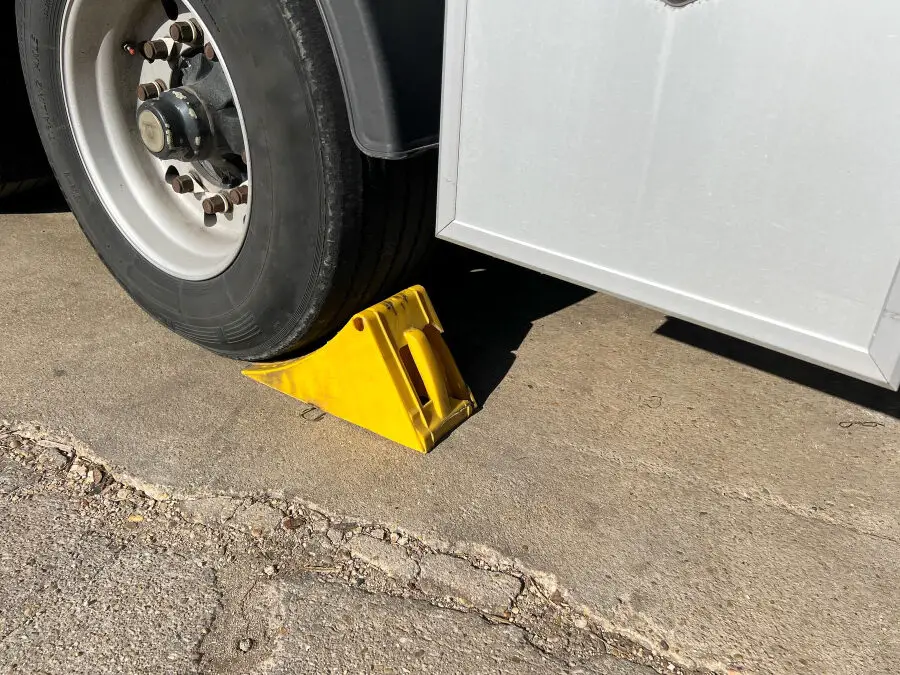
Todo lo que necesitas saber sobre las cuñas y su utilidad

El compromiso de no beber: cómo hacer un juramento efectivo
Post comment cancel reply.
Save my name, email, and website in this browser for the next time I comment.
You May Have Missed

Information
Related articles.
- Number of Views 3
- Number of Views 1
- Number of Views 5
- Number of Views 2
- Get custom product tools and services
- Access training
- Manage support cases
- Create and manage your orders (authorised partners only)
Welcome to the Schneider Electric Website
Search FAQs
How does a shunt trip work to trip a circuit breaker.
Article available in these languages: Greek , Hungarian
Released for: Schneider Electric Australia
Discuss this topic with experts
Start here!
Find answers now. Search for a solution on your own, or connect with one of our experts.
Contact Support
Reach out to our customer support team to receive more information, technical support, assistance with complaints and more.
Where to buy?
Easily find the nearest Schneider Electric distributor in your location.
Search topic-related frequently asked questions to find answers you need.
Contact Sales
Start your sales enquiry online and an expert will connect with you.

IMAGES
VIDEO
COMMENTS
A shunt trip is a device designed to switch-off the circuit breaker remotely. When energized, a shunt release instantaneously activates the circuit breaker mechanism ensuring a rapid disconnection from the power source. This device is an optional accessory in a circuit breaker that will be powered externally and can be activated thru PLC and ...
The shunt trip breaker offers extra techniques to charge the electromagnet and trip switch, helping remote or automatic power shutoff. Some hunt trips are connected to an external power supply. When power surges get that source, signal flow from shunt trip to the breaker, mechanical cutting power.
The shunt trip breaker is a combination of the shunt trip accessory and the main circuit breaker. This installs on the main breaker to add protection to your electrical system. This adds security to your electrical system as it manually or automatically cuts the electric supply in your circuit. This accessory can help prevent short circuits and ...
Shunt de 50A. En electrónica, un shunt es una carga resistiva a través de la cual se deriva una corriente eléctrica.Generalmente la resistencia de un shunt es conocida con precisión y es utilizada para determinar la intensidad de corriente eléctrica que fluye a través de esta carga, mediante la medición de la diferencia de tensión o voltaje a través de ella, valiéndose de ello de la ...
The Advantages of Installing a Shunt Trip. Installing a shunt trip circuit can provide numerous benefits, including improved safety, increased efficiency, and cost savings. Here are some of the most common uses for a shunt trip circuit: Safety: A shunt trip circuit can be used to shut down equipment in the event of an emergency, helping to ...
A shunt trip circuit breaker is a type of circuit breaker that has an additional feature called a shunt trip coil. This coil allows an external source to trip the circuit breaker remotely. When the shunt trip coil is energized, it creates a magnetic field that allows the circuit breaker to trip and open the circuit.
In the realm of electrical distribution systems, safety and control are paramount. Shunt trip breakers, a specialized type of circuit breaker, play a crucial role in enhancing safety and efficiency in various applications. This article delves into the mechanics, applications, and benefits of shunt trip breakers, shedding light on their significance in modern electrical systems.
A typical shunt trip breaker is made up of two key components: the shunt trip device and the electromagnetic coil. The shunt trip device is connected to an external control circuit, such as a manual switch, a fire alarm system, or any other device capable of generating the required signal. When this external control circuit is activated, it ...
A shunt trip device is an optional accessory for breakers that allows you to trip a circuit breaker with a remote, or automatically trip the switch during electrical surge or short circuit. Shunt trip breakers are mostly used in commercial and industrial applications to enhance safety and protection of electrical appliances. Types of shunt trip ...
Circuit Breakers. Resolution: A shunt trip device is an optional accessory in a circuit breaker that mechanically trips the breaker when power is applied to the shunt trip terminals. The power for the shunt trip does not come from within the breaker, so it must be supplied from an external source. Released for: Schneider Electric USA.
A shunt trip breaker is a specialized circuit breaker that is designed to remotely shut off power to a circuit in emergency situations, such as a fire or security breach. These breakers are commonly used in commercial and industrial buildings, as well as other facilities where safety is a top priority. In this article, we'll explore this type ...
Once your workspace is ready, follow the step-by-step process. Start by turning off the main power supply. After that, connect the shunt trip breaker to the circuit. Be sure to connect the wires correctly: the black wire to the breaker terminal, the white neutral wire to the neutral bus bar, and the green or bare ground wire to the ground bus bar.
Hay varios factores que debes tener en cuenta al seleccionar un shunt de corriente para tu aplicación: Rango de corriente: Debes seleccionar un shunt que pueda manejar el rango de corriente que se va a medir. Precisión: La precisión de un shunt es importante para garantizar mediciones exactas. Los shunts suelen tener una precisión de 0,5% a 1%.
TH(H)QB-RC breakers are available in 1, 2, and 3 pole versions and can be ordered with auxiliary contact and shunt trip accessories. TH(H)QB-RC is a member of the Q Line Miniature Circuit Breakers family. Q Line Miniature Circuit Breakers family includes: • TH(H)QC - cable-in, cable-out (lug-lug) • TH(H)QB - bolt-on with load-side ...
Shunt trip is a manual trip of a breaker, traditionally by manually shorting the circuit with a relay. Example: Elevator with sprink. You have a heat detector connected to a shunt trip relay. The heat detector is rated at a lower temperature to your sprinkler head sitting next to it at the top of the elevator shaft.
2 Technical Data TD008003EN Effective October 2021 Shunt trip safety switch EATON www.eaton.com Standards compliance • UL® 98 file number E5239 (600 Vac maximum) • CSA® file number—contact factory for specific file information (600 Vac maximum) • UL 50 • NEMA KS-1 • NEC® 230.95—Integral ground fault available for 480 Vac service entrance applications
Eaton's shunt trip safety switches, unique to the market, provide remote switching and a visible means of disconnection for commercial and industrial applications. In addition, the shunt trip technology enhances safety by providing the means to open a safety switch electronically. This product line provides additional code-compliant solutions with optional protection schemes such as arc ...
Qué son, cómo funcionan, y por qué debes conocerlas. Las resistencias shunt son resistencias normales, que se usan para medir la corriente de forma indirecta. Es decir, a partir de la tensión que hay en sus extremos, se puede calcular fácilmente la corriente que la atraviesa con una sencilla ley de Ohm. Esto es muy útil en muchos tipos de ...
Esto significa que la corriente de campo y la corriente del rotor fluyen independientemente, lo que ofrece ciertas ventajas en términos de control y rendimiento del motor. ... Por lo tanto, el motor shunt es ideal para aplicaciones en las que se requiere una velocidad constante, como en la industria textil, la industria de alimentos y bebidas ...
A Normally Open (NO) set of contacts such as a momentary pushbutton must be supplied. Hot voltage source goes to the pushbutton. One lead (wire) off of the shunt trip goes to the other side of the contacts on the pushbutton. The other lead coming out of the shunt trip goes to the neutral source from the voltage source.
A shunt trip device is an optional accessory in a circuit breaker that mechanically trips the breaker when power is applied to the shunt trip terminals. The power for the shunt trip does not come from within the breaker, so it must be supplied from an external source. Released for: Schneider Electric Australia.
shunt [sth] ⇒ vtr. (vehicle: push to side) hacer a un lado loc verb. empujar ⇒ vtr. The workers shunted the old, broken-down car off the road. Los trabajadores hicieron a un lado de la carretera al coche viejo y averiado. Los trabajadores empujaron a un lado de la carretera al coche viejo y averiado. shunt [sth/sb] ⇒ vtr.
traducir SHUNT: shunt, cortocircuito, vía. Más información en el diccionario inglés-español.